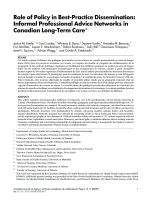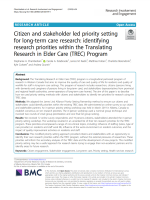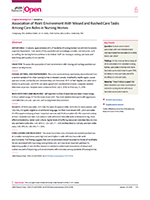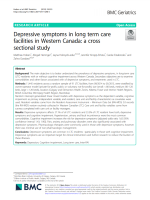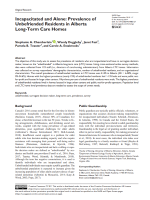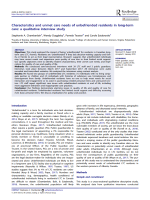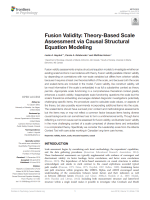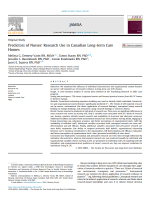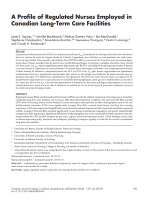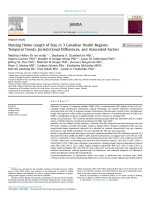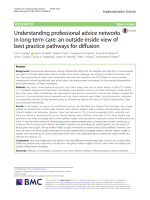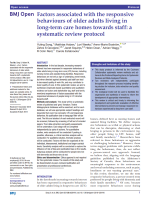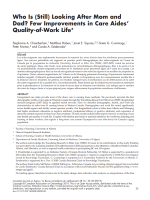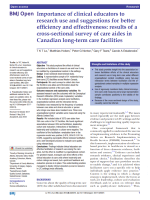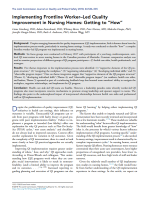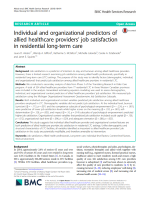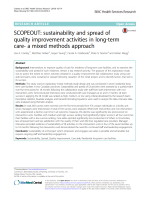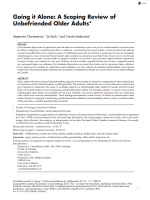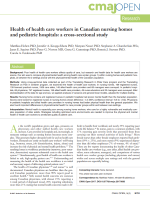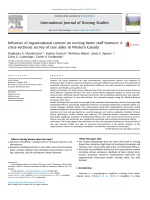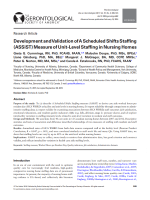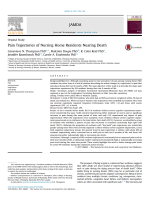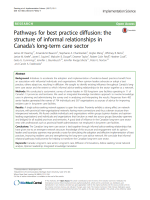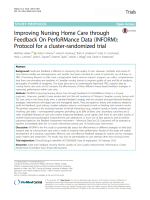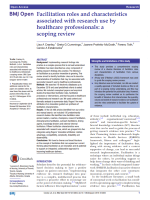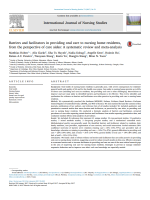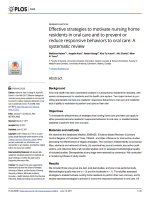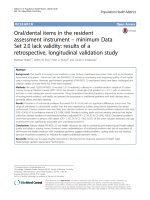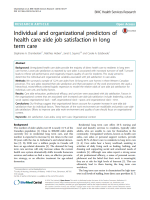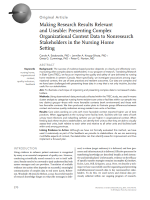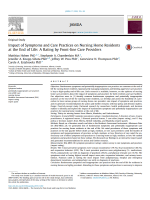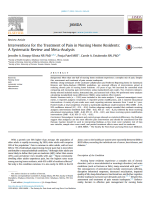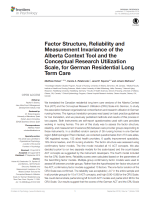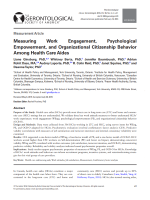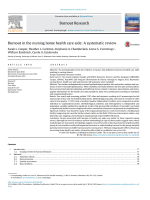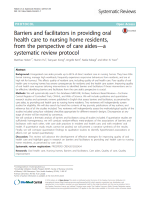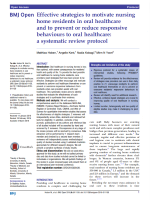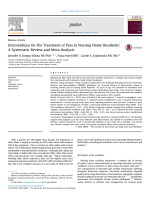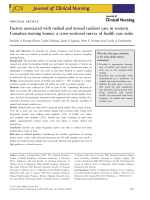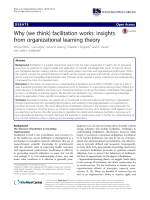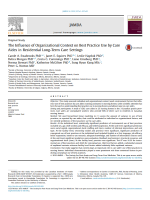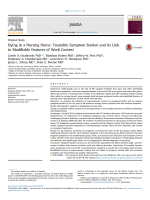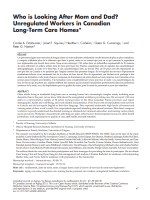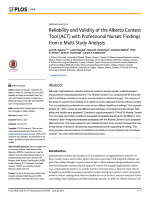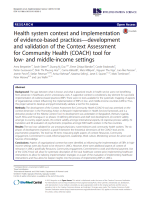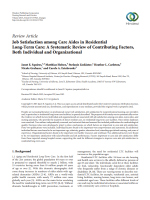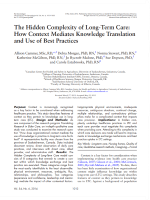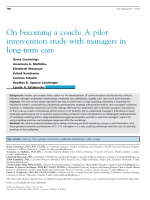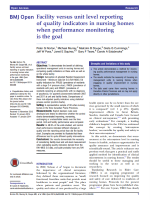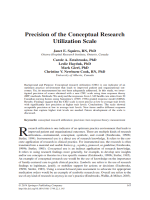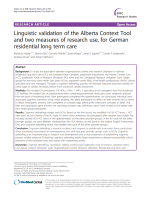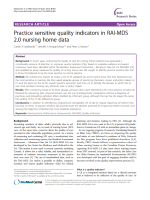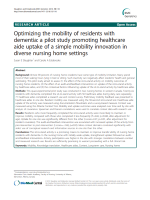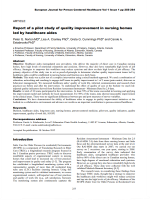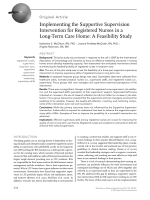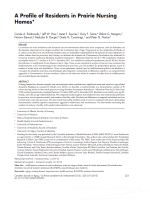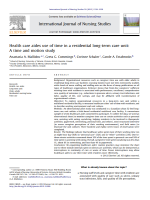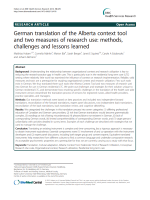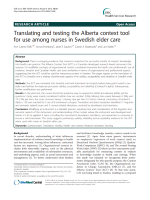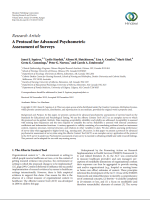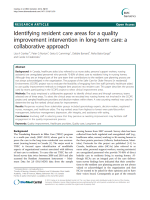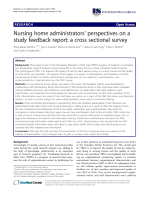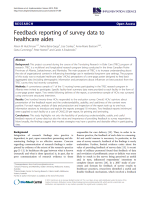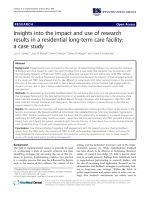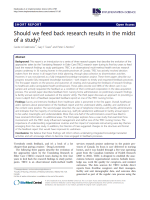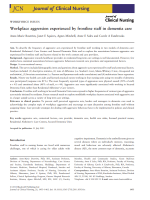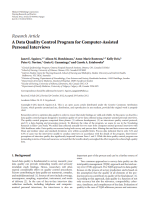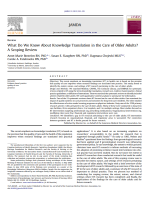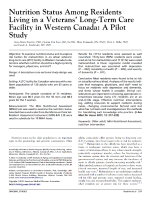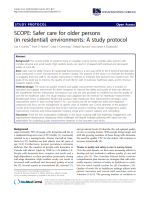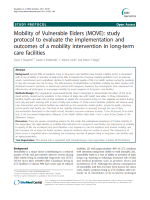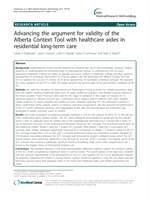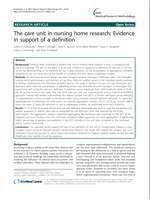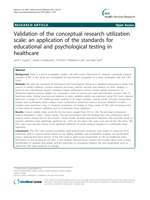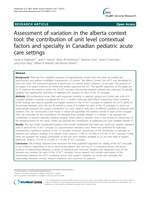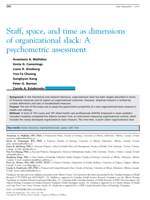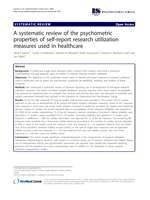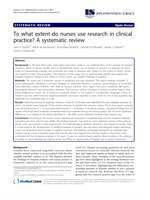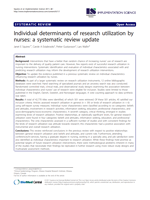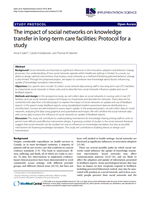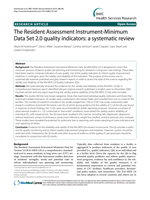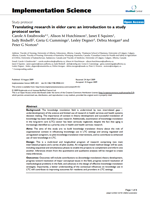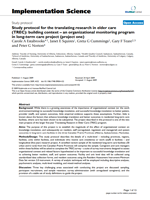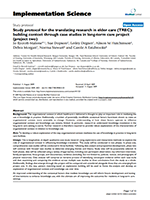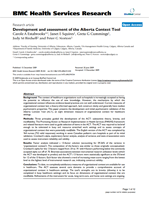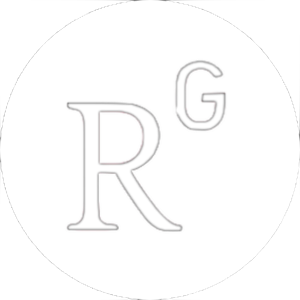Journal Articles
Peer-reviewed Journal Articles
A list of all journal articles we have published about our research in peer-reviewed scientific publications.
2020
Role of policy in best-practice dissemination: Informal professional advice networks in Canadian long-term care
Keefe J, Cranley L, Berta WB, Taylor D, Beacom AM, McAfee E, MacEachern LE, Boudreau D, Hall J, Thompson G, Squires JE, Wagg A, Estabrooks CA
Canadian Journal on Aging / La Revue canadienne du vieillissement
Abstract
This article examines provincial policy influence on long-term care (LTC) professionals’ advice-seeking networks in Canada’s Maritime provinces. The effects of facility ownership, geography, and region-specific political landscapes on LTC best-practice dissemination are examined. We used sociometric statistics and network sociograms, calculated from surveys with 169 senior leaders in LTC facilities, to identify advice-seeking network structures and to select 11 follow-up interview participants. Network structures were distinguished by density, sub-group number, opinion leader, and boundary spanner distribution. Network structure was affected by ownership model in Nova Scotia and Prince Edward Island, and by regional geography in New Brunswick. Political instability within each province’s LTC system negatively affected network actors’ capabilities to enact innovation. Moreover, provincial policy variations influence advice-seeking network structures, facilitating and constraining relationship development and networking. Consequently, local policy context is essential to informing dissemination strategy design or implementation.
Citizen and stakeholder led priority setting for long-term care research: Identifying research priorities within the Translating Research in Elder Care (TREC) Program
Chamberlain SA, Estabrooks CA, Keefe JM, Hoben M, Berendonk C, Corbett K, Gruneir A
BMC Research Involvement and Engagement, 6:24
Abstract
Background
The Translating Research in Elder Care (TREC) program is a longitudinal partnered program of research in Western Canada that aims to improve the quality of care and quality of life for residents and quality of worklife for staff in long-term care settings. This program of research includes researchers, citizens (persons living with dementia and caregivers of persons living in long-term care), and stakeholders (representatives from provincial and regional health authorities, owner-operators of long-term care homes). The aim of this paper is to describe how we used priority setting methods with citizens and stakeholders to identify ten priorities for research using the TREC data.
Methods
We adapted the James Lind Alliance Priority Setting Partnership method to ensure our citizens and stakeholders could identify priorities within the existing TREC data. We administered an online survey to our citizen and stakeholder partners. An in-person priority setting workshop was held in March 2019 in Alberta, Canada to establish consensus on ten research priorities. The in-person workshop used a nominal group technique and involved two rounds of small group prioritization and one final full group ranking.
Results
We received 72 online survey respondents and 19 persons (citizens, stakeholders) attended the in-person priority setting workshop. The workshop resulted in an unranked list of their ten research priorities for the TREC program. These priorities encompassed a range of non-clinical topics, including: influence of staffing (ratios, type of care provider) on residents and staff work life, influence of the work environment on resident outcomes, and the impact of quality improvement activities on residents and staff.
Conclusions
This modified priority setting approach provided citizens and stakeholders with an opportunity to identify their own research priorities within the TREC program, without the external pressures of researchers. These priorities will inform the secondary analyses of the TREC data and the development of new projects. This modified priority setting may be a useful approach for research teams trying to engage their non-academic partners and to identify areas for future research.
Association of work environment with missed and rushed care tasks among care aides in nursing homes
Song Y, Hoben M, Norton P, Estabrooks CA
JAMA Network Open, 19:335
Abstract
Importance
In Canada, approximately 81% of residents of nursing homes live with mild to severe cognitive impairment. Care needs of this population are increasingly complex, but resources, such as staffing, for nursing homes continue to be limited. Staff risk missing or rushing care tasks and interfering with quality of care and life.
Objective
To assess the association of work environment with missing and rushing essential care tasks in nursing homes.
Design, Setting, and Participants
This cross-sectional study used survey data collected from a random sample of 93 urban nursing homes in Western Canada, stratified by health region, owner-operator model, and facility size, between May and December 2017. All 5411 eligible care aides were invited to participate, and 4016 care aides agreed and completed structured, computer-assisted interviews in person. Analyses were conducted from July 4, 2018, to February 27, 2019.
Main Outcomes and Measures
Self-reported number of essential care tasks missed (range, 0-8) or rushed (range, 0-7) in the most recent shift. Two-level random intercept hurdle regressions controlled for care aide, care unit, and nursing home characteristics.
Results
Of 4016 care aides, 2757 (68.7%) were 40 years or older, 3574 (89.1%) were women, and 1353 (66.3%) spoke English as an additional language. For their most recent shift, 2306 care aides (57.4%) reported missing at least 1 essential care task and 2628 care aides (65.4%) reported rushing at least 1 essential care task. Care aides on units with more favorable work environments (eg, more effective leadership, better work culture, higher levels of buffering resources) were less likely to miss any care tasks (odds ratio, 1.59; 95% CI, 1.34-1.90; P < .001) and less likely to rush any care task (odds ratio, 1.66; 95% CI, 1.38-1.99; P < .001).
Conclusions and Relevance
This study found that rates of missed and rushed essential care in Canadian nursing homes were high and were higher in units with less favorable work environments. This finding suggests that work environment should be added to the list of modifiable factors associated with improving nursing home care, as it may be an important pathway for improving quality of care. Further research is needed to understand associations of missed and rushed care and of improving work environments with outcomes among residents of nursing homes.
2019
Depressive symptoms in long term care facilities in Western Canada: a cross sectional study
Hoben M, Heninger A, Holroyd-Leduc J, Knopp-Sihota J, Estabrooks CA, Goodarzi Z
BMC Geriatrics, 19:335
Abstract
Background
The main objective is to better understand the prevalence of depressive symptoms, in long-term care (LTC) residents with or without cognitive impairment across Western Canada. Secondary objectives are to examine comorbidities and other factors associated with of depressive symptoms, and treatments used in LTC.
Methods
11,445 residents across a random sample of 91 LTC facilities, from 09/2014 to 05/2015, were stratified by owner-operator model (private for-profit, public or voluntary not-for-profit), size (small: < 80 beds, medium: 80–120 beds, large > 120 beds), location (Calgary and Edmonton Health Zones, Alberta; Fraser and Interior Health Regions, British Columbia; Winnipeg Health Region, Manitoba).
Random intercept generalized linear mixed models with depressive symptoms as the dependent variable, cognitive impairment as primary independent variable, and resident, care unit and facility characteristics as covariates were used. Resident variables came from the Resident Assessment Instrument – Minimum Data Set (RAI-MDS) 2.0 records (the RAI-MDS version routinely collected in Western Canadian LTC). Care unit and facility variables came from surveys completed with care unit or facility managers.
Results
Depressive symptoms affects 27.1% of all LTC residents and 23.3% of LTC resident have both, depressive symptoms and cognitive impairment. Hypertension, urinary and fecal incontinence were the most common comorbidities. Cognitive impairment increases the risk for depressive symptoms (adjusted odds ratio 1.65 [95% confidence interval 1.43; 1.90]). Pain, anxiety and pulmonary disorders were also significantly associated with depressive symptoms. Pharmacologic therapies were commonly used in those with depressive symptoms, however there was minimal use of non-pharmacologic management.
Conclusions
Depressive symptoms are common in LTC residents –particularly in those with cognitive impairment. Depressive symptoms are an important target for clinical intervention and further research to reduce the burden of these illnesses.
Incapacitated and alone: Prevalence of unbefriended residents in Alberta long-term care homes
Chamberlain SA, Duggleby W, Fast J, Teaster P, Estabrooks CA
SAGE Open, Oct-Dec 2019, 1-7
Abstract
Characteristics and unmet needs of unbefriended residents in long-term care: a qualitative interview study
Chamberlain SA, Duggleby W, Teaster P, Estabrooks CA
Aging and Mental Health, 24, 1-9
Abstract
Objectives
This study explored the impact of being ‘unbefriended’ for residents in Canadian long-term care (LTC) homes. Residents are ‘unbefriended’ if they lack decision-making capacity and family or friends to act as their legal representative. Research suggests that unbefriended individuals may have unmet needs and experience poor quality of care due to their limited social support. Our specific objectives were to identify resident characteristics, their unmet care needs, and implications for quality of care and quality of life.
Methods
We conducted semi-structured interviews with 39 LTC staff and 3 public guardians. Interviews took place between March 2017 and September 2017. All interviews were audio recorded and transcribed verbatim. We analyzed the interviews using content analysis.
Results
We found two groups of unbefriended LTC residents: (1) individuals with no living conjugate partner or children and (2) individuals with histories of substance use, homelessness, and estrangement from family. Unbefriended residents have no one to help meet needs for social interaction and engagement or to assist in purchasing needed personal items and uninsured services. LTC staff report significant care issues with unbefriended residents at end of life, including more aggressive behaviors and inappropriate care practices.
Conclusion
Our findings demonstrate alarming issues in quality of life and quality of care for unbefriended residents. Unbefriended residents had limited social support and difficulty accessing even basic personal items. We discuss implications for policy and practice.
Fusion validity: Theory-based scale assessment via causal structural equation modelling
Hayduk L, Estabrooks CA, Hoben M
Frontiers in Psychology, 10:1139
Abstract
Fusion validity assessments employ structural equation models to investigate whether an existing scale functions in accordance with theory. Fusion validity parallels criterion validity by depending on correlations with non-scale variables but differs from criterion validity because it requires at least one theorized effect of the scale, and because both the scale and scaled-items are included in the model. Fusion validity, like construct validity, will be most informative if the scale is embedded in as full a substantive context as theory permits. Appropriate scale functioning in a comprehensive theoretical context greatly enhances a scale's validity. Inappropriate scale functioning questions the scale but the scale's theoretical embedding encourages detailed diagnostic investigations potentially challenging specific items, the procedure used to calculate scale values, or aspects of the theory, but also possibly recommends incorporating additional items into the scale. The scaled items should have survived prior content and methodological assessments but the items may or may not reflect a common factor because items having diverse causal backgrounds can sometimes fuse to form a unidimensional entity. Though items reflecting a common cause can be assessed for fusion validity, we illustrate fusion validity in the more challenging context of a scale comprised of diverse items and embedded in a complicated theory. Specifically we consider the Leadership scale from the Alberta Context Tool with care aides working in Canadian long-term care homes.
Predictors of nurses' research use in Canadian long-term care homes
Demery Varin MG, Stacey D, Baumbusch JL, Estabrooks CA, Squires JE
Journal of the American Medical Directors Association, 20(9), 1185.e9-1185.e18
Abstract
Objectives
We examined the influence of individual characteristics and organizational context features on nurses' self-reported use of research evidence in long-term care (LTC) homes.
Design
A cross-sectional analysis of survey data collected in the Translating Research in Elder Care program.
Setting and participants
756 nurses (registered nurses and licensed practical nurses) from 89 LTC homes in Western Canada.
Methods
Generalized estimating equation modeling was used to identify which individual characteristics and organizational context features significantly predicted (P < .05) 3 kinds of self-reported research use by nurses: instrumental (the direct application of research findings), conceptual (using research findings to change thinking), and persuasive (using research findings to convince others).
Results
Nurses reported a moderate to high level of research use. There were no significant differences in mean research use scores by nursing role. Only 2 variables were associated with all 3 kinds of research use: having a positive attitude toward research, and availability of structural and electronic resources. Additional variables associated with instrumental research use were problem-solving ability, engaging in formal interactions (eg, education sessions), and better perceptions of organizational slack–staff (the availability of sufficient staff). Additional variables associated with conceptual research use were self-determination and job efficacy. Finally, additional variables associated with persuasive research use were belief suspension (the ability to suspend previously held beliefs), organizational citizenship behavior (one's voluntary commitment to the organization), self-determination, job efficacy, evaluation, and better perceptions of organizational slack–time (perceived availability of extra time).
Conclusions and implications
Conceptual and persuasive research use were most strongly influenced by individual characteristics, whereas instrumental research use was predicted equally by individual and organizational variables. Nurses working in LTC are positioned in leadership roles; by targeting both the individual- and organizational-level predictors of nurses' research use, they can improve conditions for individuals living in LTC.
A profile of regulated nurses employed in Canadian long-term care facilities
Squires JE, Baumbusch J, Demery Varin M, MacDonald I, Chamberlain S, Boström AM, Thompson G, Cummings G, Estabrooks CA
Canadian Journal on Aging / La Revue canadienne du vieillissement, 38(2), 130-142
Abstract
Registered nurses (RNs) and licensed practical nurses (LPNs) provide the skilled component of nursing care in Canadian residential long-term care facilities, yet we know little about this important workforce. We surveyed 309 RNs and 448 LPNs from 91 nursing homes across Western Canada and report descriptively on their demographics and work and health-related outcomes. LPNs were significantly younger than RNs, worked more hours, and had less nursing experience. LPNs also experienced significantly more dementia-related responsive behaviours from residents compared to RNs. Younger LPNs and RNs reported significantly worse burnout (emotional exhaustion) and poorer mental health compared to older age groups. Significant differences in demographics and work- and health-related outcomes were also found within the LPN and RN samples by province, region, and owner-operator model. These findings can be used to inform important policy decisions and workplace planning to improve quality of work life for nurses in residential long-term care facilities.
Nursing home length of stay in 3 Canadian health regions: temporal trends, jurisdictional differences, and associated factors
Hoben M, Chamberlain SA, Gruneir A, Knopp-Sihota JA, Sutherland JM, Poss JW, Doupe MB, Bergstrom V, Norton PG, Schalm C, McCarthy K, Kashuba K, Ackah F, Estabrooks CA
Journal of the American Medical Directors Association, 20(9):1121-1128
Abstract
Objectives
To assess (1) temporal changes (2008–2015) in nursing home (NH) length of stay (LoS) in 3 Canadian health jurisdictions (Edmonton, Calgary, Winnipeg), (2) resident admission characteristics associated with LoS, and (3) temporal changes of admission characteristics in each of the 3 jurisdictions.
Design
Retrospective cohort study using data previously collected in Translating Research in Elder Care (TREC), a longitudinal program of applied health services research in Canadian NHs.
Setting and participants
7817 residents admitted between January 2008 and December 2015 to a stable cohort of 18 NHs that have consistently participated in TREC since 2007.
Methods
LoS was defined as time between a resident's first NH admission and final discharge from the NH sector. Analyses included descriptive statistics, Kaplan Meier estimates (unadjusted LoS), and Cox proportional hazard regressions (adjusted LoS), adjusted for resident characteristics (eg, age, cognitive performance, and health instability). We also controlled for NH size and ownership.
Results
In jurisdictions with increasing care needs, unadjusted median LoS [95% confidence interval (CI)] decreased over time (2008 and 2009 vs 2014 and 2015 admissions); in Calgary from 1.837 (95% CI 1.618, 2.275) to 1.328 (95% CI 1.185, 1.489) years and in Edmonton from 1.927 (95% CI 1.725, 2.188) to 1.073 (95% CI 0.936, 1.248) years. In Winnipeg, care needs and LoS remained constant (2.163, 95% CI 1.867, 2.494, vs 2.459, 95% CI 2.155, 2.883, years). Resident characteristics including higher physical dependency [hazard ratio (HR) 1.205, 95% CI 1.133, 1.282], higher cognitive impairment (HR 1.112, 95% CI 1.042, 1.187), or higher health instability (HR 1.333, 95% CI 1.224, 1.452) were associated with lower LoS. Adjustment for resident characteristics reduced jurisdictional LoS differences and rendered temporal LoS differences within jurisdictions statistically nonsignificant.
Conclusions/Implications
In jurisdictions where care needs at admission have increased since 2008, resident LoS has decreased. Jurisdictional differences in care needs and LoS indicate that health policies may affect these outcomes. Variations of resident outcomes by policy environment require additional scrutiny.
Understanding professional advice networks in long-term care: An outside-inside view of best practice pathways for diffusion
Cranley LA, Keefe JM, Taylor D, Thompson G, Beacom AM, Squires JE, Estabrooks CA, Dearing JW, Norton PG, Berta WB
Implementation Science, 14:10
Abstract
Background
Interpersonal relationships among professionals drive both the adoption and rejection of consequential innovations. Through relationships, decision-makers learn which colleagues are choosing to adopt innovations, and why. The purpose of our study was to understand how and why long-term care (LTC) leaders in a pan-Canadian interpersonal network provide and seek advice about care improvement innovations, for the eventual dissemination and implementation of these innovations.
Methods
We used a mixed methods approach. An online survey was sent to senior leaders in 958 LTC facilities in 11 Canadian provinces and territories. Participants were asked to name up to three individuals whose advice they most value when considering care improvement and practice innovations. Sociometric analysis revealed the structure of provincial-level advice networks and how those networks were linked. Using sociometric indicators, we purposively selected 39 key network actors to interview to explore the nature of advice relationships. Data were analyzed thematically.
Results
In this paper, we report our qualitative findings. We identified four themes from the data. One theme related to characteristics of particular network roles: opinion leaders, advice seekers, and boundary spanners. Opinion leaders and boundary spanners have long tenures in LTC, a broad knowledge of the network, and share an interest in advancing the sector. Advice seekers were similarly committed to LTC; they initially seek and then, over time, exchange advice with opinion leaders and become an important source of information for them. A second theme related to characterizing advice seeking relationships as formal, peer-to-peer, mentoring, or reciprocal. The third and fourth themes described motivations for providing and seeking advice, and the nature of advice given and sought. Advice seekers initially sought information to resolve clinical care problems; however, over time, the nature of advice sought expanded to include operational and strategic queries. Opinion leaders sought to expand their networks and to solicit information from their more established advice seekers that might benefit the network and advance LTC.
Conclusions
New knowledge about the distinct roles that different network actors play vis-a-vis one another offers healthcare professionals, researchers, and decision- and policy-makers insights that are useful when formulating best practice dissemination strategies.
Factors associated with the responsive behaviours of older adults living in long-term care homes towards staff: a systematic review protocol
Song Y, Hoben M, Weeks LE, Boström AM, Goodarzi Z, Squires JE, Doan H, Wagg A, Reid C, Estabrooks CA
BMJ Open, 9:e028416
Abstract
Introduction
In the last decade, increasing research interest has been expressed in responsive behaviours of older adults living in long-term care (LTC) homes, including nursing homes and assisted living facilities. Responsive behaviours are not only a sign of underlying unmet needs, but when directed against (towards) paid staff can lead to decreased quality of work life, and may contribute to lower quality of care. In this systematic review, we aim to synthesise empirically based quantitative and qualitative evidence on factors and stakeholder (eg, staff and family members) experiences of factors associated with the responsive behaviours of people living in LTC directed towards staff.
Methods and analysis
This study will be a systematic review of published and ‘grey’ literature. Twelve bibliographical databases will be searched, and for each database, we will use appropriate subject headings and keywords that cover two concepts: LTC and responsive behaviour. No publication date or language filter will be used. The title and abstract of each extracted record will be screened, followed by screening of full text of included papers. Then data extraction and quality assessments will be undertaken. Each stage will be completed independently by pairs of authors. For quantitative studies, meta-analysis will be conducted if pooling is possible; otherwise, a critical narrative analysis will be conducted. For qualitative studies, thematic analysis will be conducted. Factors will then be organised at the individual, interpersonal, institutional and larger societal levels. Sensitivity analysis will be conducted to explore the influence of risk of bias and publication bias on the results. Subgroup analysis will be conducted for people who live with dementia and those who do not.
Ethics and dissemination
Ethics approval is not required for this systematic review. The results of this study will be disseminated via peer-reviewed publication and presentation at professional conferences.
Who is (still) looking after mom and dad? Few improvement in care aides’ quality-of-work life
Chamberlain SA, Hoben M, Squires JE, Cummings GG, Norton PG, Estabrooks CA
Canadian Journal on Aging, 38(1), 35-50
Abstract
Unregulated care aides provide most of the direct care to nursing home residents. We previously reported the first demographic profile of care aides in Western Canada through the Translating Research in Elder Care (TREC) longitudinal research program (2007–2022) in applied health services. Here we describe demographic, health, and work life characteristics of aides from 91 nursing homes in Western Canada. Demographics and work life varied significantly across health regions and facility owner-operator models. Our longitudinal cohort of aides from Alberta and Winnipeg had higher emotional exhaustion (a negative attribute), professional efficacy (a positive attribute), and experience of dementia-related responsive behaviours from residents. Overall, results indicate little improvement or worsening of care aide health and quality of work life. Coupled with limited provincial or national initiatives for workforce planning and training of these workers, this signals a long-term care system ill-prepared to care effectively for Canada’s aging population.
Les aides-soignants non réglementés fournissent la majorité des soins directs dans les résidences pour personnes âgées. Nos travaux précédents ont rapporté un premier profil démographique des aides-soignants de l’ouest du Canada par le programme de recherche Translating Research in Elder Care (TREC; 2007-2022) visant les services de santé appliqués. Dans cette étude, nous présentons les caractéristiques démographiques, liées à la santé et à la vie professionnelle d’aides-soignants provenant de 91 résidences pour personnes âgées de l’ouest du Canada. Les données démographiques et liées au travail ont significativement varié selon les régions et les modèles de propriété ou d’opération. Notre cohorte longitudinale de l’Alberta et de Winnipeg présentait davantage d’épuisement émotionnel (attribut négatif), d’efficacité professionnelle (attribut positif) et d’expérience avec les comportements réactifs liés à la démence chez les résidents. En général, les résultats indiquent peu d’amélioration ou de détérioration de la santé des aides-soignants et de la qualité de la vie professionnelle. Étant donné que les initiatives provinciales et nationales pour la planification et la formation de la main-d’œuvre dans ce domaine sont limitées, ceci indique que le système des soins de longue durée n’est pas préparé pour soigner efficacement la population canadienne vieillissante.
2018
Importance of clinical educators to research use and suggestions for better efficiency and effectiveness: results of a cross-sectional survey of care aides in Canadian long-term care facilities
Lo TKT, Hoben M, Norton PG, Teare G, Estabrooks CA
BMJ Open, 8:e020074
Abstract
Objective
This study explored the effect of clinical educators as facilitators of research use and how it may be modified by organisational context in the settings.
Design
Cross-sectional observational study.
Setting
A representative sample of 91 residential long-term care (LTC) facilities across Western Canada.
Participants
We used surveys to collect data from the frontline care aides and information about the organisational context of the care units.
Outcome measure and explanatory variables
We assessed research use (the outcome) with the Conceptual Research Utilization (CRU) scale. Explanatory variables in the multiple regression analysis were facilitation, organisational context and the interaction terms. Facilitation was measured by the frequency of contacts between care aides and clinical educator or person who brings new ideas about resident care. Three core organisational context variables were measured using the Alberta Context Tool.
Results
We included data of 3873 care aides from 294 care units in the LTC facilities. We found significant associations between CRU and facilitation, leadership, culture and evaluation. Interactions of facilitation x leadership and facilitation x culture were negative. The coefficient of the facilitation x evaluation term in the regression model was positive (0.019, 95% CI 0.012 to 0.026), suggesting synergistic effects between facilitation and a well-developed process to evaluate care quality using relevant data.
Conclusions
Findings indicate clinical educators are effective facilitators of research use among the care aides, but the effect is modified by organisational context. For greatest impact, managers can direct efforts of the clinical educators to care units where leadership and culture ratings are lowest, but a proficient feedback and evaluation process is in place. This understanding enables managers to deploy clinical educators (a scarce resource in LTC settings) most efficiently.
Implementing frontline-worker–led quality improvement in nursing homes: Getting to “how”
Ginsburg L, Easterbrook A, Berta W, Norton PG, Doupe M, Knopp-Sihota J, Anderson R, Wagg A
Joint Commission Journal on Quality Improvement, 44(9), 526-535
Abstract
Background
Despite emerging frameworks for quality improvement (QI) implementation, little is known about how the implementation process works, particularly in nursing home settings. A study was conducted to describe “how”’ a complex frontline worker–led QI program was implemented in nursing homes.
Methods
Six focus groups were conducted in February 2017 with participants of a year-long, multicomponent, unit-level QI intervention in seven nursing homes in the Canadian province of Manitoba. Constant comparative analysis was used to examine perspectives of different groups of QI program participants—35 health care aides, health professionals, and managers.
Results
Five themes important to the implementation process were identified: (1) “supportive elements of the QI program structure,” (2) “navigating the workplace,” (3) “negotiating relationships,” (4) “developing individual skills,” and (5) “observable program impact.” Data on theme integration suggest that “supportive elements of the QI program structure” (Theme 1), “developing individual skills” (Theme 4), and “observable program impact” (on residents, health care aides, and leaders; Theme 5) operated as part of a reinforcing feedback loop that boosted team members’ ability to navigate the workplace, negotiate relationships, and implement the QI program.
Conclusion
Health care aide–led QI teams are feasible. However, a leadership paradox exists whereby worker-led QI programs also must incorporate concrete mechanisms to promote strong leadership and sponsor support to teams. The findings also point to the underexplored impact of interpersonal relationships between health care aides and professional staff on QI implementation.
Individual and organizational predictors of allied healthcare providers' job satisfaction in residential long-term care
Aloisio LD, Gifford WA, McGilton KS, Lalonde M, Estabrooks CA, Squires JE
BMC Health Services Research, 18:491
Abstract
Background
Job satisfaction is a predictor of intention to stay and turnover among allied healthcare providers. However, there is limited research examining job satisfaction among allied health professionals, specifically in residential long-term care (LTC) settings. The purpose of this study was to identify factors (demographic, individual, and organizational) that predict job satisfaction among allied healthcare providers in residential LTC.
Methods
We conducted a secondary analysis of data from Phase 2 of the Translating Research in Elder Care program. A total of 334 allied healthcare providers from 77 residential LTC in three Western Canadian provinces were included in the analysis. Generalized estimating equation modeling was used to assess demographics, individual, and organizational context predictors of allied healthcare providers' job satisfaction. We measured job satisfaction using the Michigan Organizational Assessment Questionnaire Job Satisfaction Subscale.
Results
Both individual and organizational context variables predicted job satisfaction among allied healthcare providers employed in LTC. Demographic variables did not predict job satisfaction. At the individual level, burnout (cynicism) (β = -.113, p = .001) and the competence subscale of psychological empowerment (β = -.224, p = < .001), were predictive of lower job satisfaction levels while higher scores on the meaning (β = .232, p = .001), self-determination (β = .128, p = .005), and impact (β = .10, p = .014) subscales of psychological empowerment predicted higher job satisfaction. Organizational context variables that predicted job satisfaction included: social capital (β = .158, p = .012), organizational slack-time (β = .096, p = .029), and adequate orientation (β = .088, p = .005).
Conclusions
This study suggests that individual allied healthcare provider and organizational context features are both predictive of allied healthcare provider job satisfaction in residential LTC settings. Unlike demographics and structural characteristics of LTC facilities, all variables identified as important to allied healthcare providers' job satisfaction in this study are potentially modifiable, and therefore amenable to intervention.
Engagement-capable environments – No less challenging than other large system changes
Estabrooks CA
HealthcarePapers, 17(2), 40-45
Abstract
Kuluski et al.'s (2017) argument for including a more advanced form of health system performance management centred on "the experience of care," raises the major challenge of creating and sustaining engagement-capable environments. Here I briefly address frameworks that may be useful in meeting this challenge – Complex Adaptive Systems, Innovation Diffusion, Whole System Change. I also offer a personal perspective drawn from a successful citizen engagement experience, concluding with a perspective on the numerous challenges we have or are in the process of overcoming compared to the challenges of engagement-capable environments.
SCOPEOUT: sustainability and spread of quality improvement activities in long-term care- a mixed methods approach
Cranley LA, Hoben M, Yeung J, Estabrooks CA, Norton PG, Wagg AS
BMC Health Services Research, 18:171
Abstract
Background
Interventions to improve quality of care for residents of long-term care facilities, and to examine the sustainability and spread of such initiatives, remain a top research priority. The purpose of this exploratory study was to assess the extent to which activities initiated in a quality improvement (QI) collaborative study using care aide led teams were sustained or spread following cessation of the initial project and to identify factors that led to its success.
Methods
This study used an exploratory mixed methods study design and was conducted in seven residential long-term care facilities in two Canadian provinces. Sustainability and spread of QI activities were assessed by a questionnaire over five time points for 18 months following the collaborative study with staff from both intervention with non-intervention units. Semi-structured interviews were conducted with care managers at six and 12 months. QI team success in applying the QI model was ranked as high, medium, or low using criteria developed by the research team. Descriptive statistics, bivariate analyses, and General Estimating Equations were used to analyze the data. Interview data were analyzed using thematic analysis.
Results
In total, 683 surveys were received over the five time periods from 476 unique individuals on a facility unit. Seven managers were interviewed. A total of 533 surveys were analyzed. While both intervention and non-intervention units experienced a decline over time in all outcome measures, this decline was significantly less pronounced on intervention units. Facilities with medium and high success ranking had significantly higher scores in all four outcomes than facilities with a low success ranking. Care aides reported significantly less involvement of others in QI activities, less empowerment and less satisfaction with the quality of their work life than regulated care providers. Manager interviews provided evidence of sustainability of QI activities on the intervention units in four of the seven facilities up to 18 months following the intervention and demonstrated the need for continued staff and leadership engagement.
Conclusion
Sustainability of a QI project which empowers and engages care aides is possible and achievable, but requires ongoing staff and leadership engagement.
Going it alone: A scoping review of unbefriended older adults
Chamberlain SA, Baik S, Estabrooks CA
Canadian Journal on Aging, 37(1), 1-11
Abstract
Older adults who have reduced decision-making capacity and no family or friends to compensate for these deficiencies are known as unbefriended and require a public guardian. The purpose of this study was to review the peer-reviewed and grey literature to determine the scope of available research on unbefriended older adults in Canada and the United States. We found limited research examining unbefriended older adults. No Canadian studies or reports were located. Unbefriended older adults were childless or had fewer children, were more cognitively impaired, and were older than older adults who were not unbefriended. These findings demonstrate a stark scarcity of studies on unbefriended older adults. Research is urgently needed using standardized data collection of guardianship status in order to enable studies of the prevalence of public guardianship in Canada.
Les personnes âgées dont la capacité de prise de décision est réduite et qui n’ont pas de soutien familial ou d’amis pour les aider à compenser ces déficits sont dites « solitaires » et nécessitent un tuteur public. Le but de cette étude était de recenser les publications avec comités de pairs et la littérature grise afin d’examiner la portée des travaux de recherches réalisés jusqu’à ce jour concernant les personnes âgées solitaires au Canada et aux États-Unis. Nous n’avons recensé que peu d’études sur ce sujet. Aucune étude ou rapport canadien n’a été trouvé. Les personnes âgées solitaires étaient plus avancées en âge, sans enfants ou avec peu d’enfants, et leurs troubles cognitifs étaient plus sévères, comparativement aux personnes âgées non solitaires. Ces résultats démontrent une rareté des études sur les personnes âgées solitaires. Il est urgent que davantage de recherches soient réalisées avec des collectes de données standardisées concernant la tutelle chez les personnes âgées solitaires afin de faciliter la réalisation d’études sur la prévalence de la tutelle publique au Canada.
2017
Health of health care workers in Canadian nursing homes and pediatric hospitals: A cross-sectional study
Hoben M, Knopp-Sihota JA, Nesari M, Chamberlain SA, Squires JE, Norton PG, Cummings GG, Stevens BJ, Estabrooks CA
CMAJ Open, 5(4), E791-E799
Abstract
Background
Poor health of health care workers affects quality of care, but research and health data for health care workers are scarce. Our aim was to compare physical/mental health among health care worker groups 1) within nursing homes and pediatric hospitals, 2) between the 2 settings and 3) with the physical/mental health of the Canadian population.
Methods
Using cross-sectional data collected as part of the Translating Research in Elder Care program and the Translating Research on Pain in Children program, we examined the health of health care workers. In nursing homes, 169 registered nurses, 139 licensed practical nurses, 1506 care aides, 145 allied health care providers and 69 managers were surveyed. In pediatric hospitals, 63 physicians, 747 registered nurses, 155 allied health care providers, 49 nurse educators and 22 managers were surveyed. After standardization of the data for age and sex, we applied analyses of variance and general linear models, adjusted for multiple testing.
Results
Nursing home workers and registered nurses in pediatric hospitals had poorer mental health than the Canadian population. Scores were lowest for registered nurses in nursing homes (mean difference -4.4 [95% confidence interval -6.6 to -2.6]). Physicians in pediatric hospitals and allied health care providers in nursing homes had better physical health than the general population. We also found important differences in physical/mental health for care provider groups within and between care settings.
Interpretation
Mental health is especially poor among nursing home workers, who care for a highly vulnerable and medically complex population of older adults. Strategies including optimized work environments are needed to improve the physical and mental health of health care workers to ameliorate quality of patient care.
Influence of organizational context on nursing home staff burnout: A cross-sectional survey of care aides in Western Canada
Chamberlain S, Gruneir A, Hoben M, Squires J, Cummings G, Estabrooks CA
International Journal of Nursing Studies, 71, 60-69
Abstract
Purpose
Our study examined care aide characteristics, organizational context, and frequency of dementia-related resident responsive behaviours associated with burnout. Burnout is the experience of emotional exhaustion, cynicism, and professional inefficacy. Care aide burnout has implications for turnover, staff health, and quality of care.
Design and methods
We used surveys collected from 1194 care aides from 30 urban nursing homes in three Western Canadian provinces. We used a mixed-effects regression analysis to assess care aide characteristics, dementia-related responsive behaviours, unit and facility characteristics, and organizational context predictors of care aide burnout. We measured burnout using the Maslach Burnout Inventory, Short Form.
Results
We found that care aides were at high risk for emotional exhaustion and cynicism, but report high professional efficacy. Statistically significant predictors of emotional exhaustion included English as a second language, medium facility size, organizational slack-staff, organizational slack-space, health (mental and physical) and dementia-related responsive behaviours. Statistically significant predictors of cynicism were care aide age, English as a second language, unit culture, evaluation (feedback of data), formal interactions, health (mental and physical) and dementia-related responsive behaviours. Statistically significant predictors of professional efficacy were unit culture and structural resources. Greater care aide job satisfaction was significantly associated with increased professional efficacy.
Implications
This study suggests that individual care aide and organization features are both predictive of care aide burnout. Unlike care aide or structural characteristics of the facility elements of the organizational context are potentially modifiable, and therefore amenable to intervention.
Development and validation of A Scheduled Shifts Staffing (ASSiST) measure of unit-level staffing in nursing homes
Cummings GG, Doupe M, Ginsburg L, McGregor M, Norton PG, Estabrooks CA
The Gerontologist, 75(3), 509-516
Abstract
Purpose of the study
To (a) describe A Scheduled Shifts Staffing measure (ASSiST) to derive care aide worked hours per resident day (HCA WHRD) at facility and unit levels in nursing homes, (b) report reliability through comparisons to administrative staffing data; (c) report validity by examining associations between HCA WHRD, staff outcomes (job satisfaction, emotional exhaustion), and resident quality indicators (QIs) (e.g. falls, delirium, stage 2+ pressure ulcers), and (d) explore intrafacility variation in staffing intensity levels related to unit-level variation in resident and staff outcomes.
Design and Methods
We used data from 40 care units in 12 Canadian nursing homes between 2007 and 2012. Descriptive statistics and tests of association and difference described relationships of two measures of staffing with resident and staff outcomes.
Results
Annualized rates of HCA WHRD from both data sources compared well at the facility level (Pearson Product Correlation; R = 0.847, p < .001), and were correlated similarly to staff work life and many QIs. Using ASSiST data, we show that staffing levels can vary by up to 40% at the unit-level within nursing homes.
Implications
ASSiST is easy to collect, more timely to retrieve than administrative data, has good criterion and construct validity, and reflects intrafacility variation in health care aide staffing levels.
Pain trajectories of nursing home residents nearing death
Thompson, G.N., Doupe, M., Reid, R.C., Baumbusch, J., Estabrooks, C.A
Journal of the American Medical Directors Association, 18(8), 700-706
Abstract
Background/Objectives
Although examining point in time prevalence of pain among nursing home (NH) residents has value, there is a lack of evidence describing the actual changes (ie, trajectories) in pain that take place during their last 6 months of life. The main objective of this study is to describe the major pain trajectories experienced by NH residents during their last 6 months of life.
Design
Secondary analysis of Resident Assessment Instrument-Minimum Data Set (MDS) 2.0 data captured as part of the longitudinal Translating Research in Elder Care data repository.
Setting
Twenty-seven urban NHs in Western Canada.
Participants
A total of 962 NH residents who died, had an MDS assessment completed within 30 days of death, and resided in a NH for at least 6 months. Pain trajectories were stratified by residents who were not severely cognitively impaired [Cognitive Performance Scale (CPS) ≤3] and those with severe impairment (CPS ≥4) at death.
Measurements
MDS-Pain Scale; CPS.
Results
In the 6 months before death, 60.1% of residents without severe cognitive impairment experienced consistently low pain; 34.6% reported experiencing either moderate to severe pain or significant increases in pain during this same period of time, and only 5.3% experienced any degree of pain improvement. When the trajectories were examined, most residents without severe cognitive impairment experienced no to mild pain in the time before their death (65.5%); however, we identified a group of residents who exhibited a pattern of pain that worsened or remained consistently high right until death (38.2%). Although the proportion of residents with “low/mild” pain trajectories was statistically greater among those who were severely impaired vs those without severe cognitive impairment, across both cognitive impairment groups, the general trend in pain trajectories is similar; with about 60% of residents experiencing either consistent low or mild pain in their last 6 months of life, and about 34% experiencing either substantially high or increasing pain levels.
Conclusions
Although a majority of NH residents experienced consistently low or improved pain levels in their last 6 months of life, a substantial number experienced consistently high or substantially worsening pain levels during this same time period. These results highlight the need to better manage pain levels for some NH residents during this important period of time.
Pathways for best practice diffusion: the structure of informal relationships in Canada’s long-term care sector
Dearing JW, Beacom AM, Chamberlain SA, Meng J, Berta WB, Keefe JM, Squires JE, Doupe MB, Taylor D, Reid RC, Cook H, Cummings GG, Baumbusch JL, Knopp-Sihota J, Norton PG, Estabrooks CA
Implementation Science 12:11
Abstract
Background
Initiatives to accelerate the adoption and implementation of evidence-based practices benefit from an association with influential individuals and organizations. When opinion leaders advocate or adopt a best practice, others adopt too, resulting in diffusion. We sought to identify existing influence throughout Canada’s long-term care sector and the extent to which informal advice-seeking relationships tie the sector together as a network.
Methods
We conducted a sociometric survey of senior leaders in 958 long-term care facilities operating in 11 of Canada’s 13 provinces and territories. We used an integrated knowledge translation approach to involve knowledge users in planning and administering the survey and in analyzing and interpreting the results. Responses from 482 senior leaders generated the names of 794 individuals and 587 organizations as sources of advice for improving resident care in long-term care facilities.
Results
A single advice-seeking network appears to span the nation. Proximity exhibits a strong effect on network structure, with provincial inter-organizational networks having more connections and thus a denser structure than interpersonal networks. We found credible individuals and organizations within groups (opinion leaders and opinion-leading organizations) and individuals and organizations that function as weak ties across groups (boundary spanners and bridges) for all studied provinces and territories. A good deal of influence in the Canadian long-term care sector rests with professionals such as provincial health administrators not employed in long-term care facilities.
Conclusions
The Canadian long-term care sector is tied together through informal advice-seeking relationships that have given rise to an emergent network structure. Knowledge of this structure and engagement with its opinion leaders and boundary spanners may provide a route for stimulating the adoption and effective implementation of best practices, improving resident care and strengthening the long-term care advice network. We conclude that informal relational pathways hold promise for helping to transform the Canadian long-term care sector.
Improving Nursing Home Care through Feedback On PerfoRMance Data (INFORM): Protocol for a cluster-randomized trial
Hoben M, Norton PG, Ginsburg LR, Anderson RA, Cummings GG, Lanham HJ, Squires JE, Taylor D, Wagg AS, Estabrooks CA
Trials 18:9
Abstract
Background
Audit and feedback is effective in improving the quality of care. However, methods and results of international studies are heterogeneous, and studies have been criticized for a lack of systematic use of theory. In TREC (Translating Research in Elder Care), a longitudinal health services research program, we collect comprehensive data from care providers and residents in Canadian nursing homes to improve quality of care and life of residents, and quality of worklife of caregivers. The study aims are to a) systematically feed back TREC research data to nursing home care units, and b) compare the effectiveness of three different theory-based feedback strategies in improving performance within care units.
Methods
INFORM (Improving Nursing Home Care through Feedback On PerfoRMance Data) is a 3.5-year pragmatic, three-arm, parallel, cluster-randomized trial. We will randomize 67 Western Canadian nursing homes with 203 care units to the three study arms, a standard feedback strategy and two assisted and goal-directed feedback strategies. Interventions will target care unit managerial teams. They are based on theory and evidence related to audit and feedback, goal setting, complex adaptive systems, and empirical work on feeding back research results. The primary outcome is the increased number of formal interactions (e.g., resident rounds or family conferences) involving care aides – non-registered caregivers providing up to 80% of direct care. Secondary outcomes are a) other modifiable features of care unit context (improved feedback, social capital, slack time) b) care aides’ quality of worklife (improved psychological empowerment, job satisfaction), c) more use of best practices, and d) resident outcomes based on the Resident Assessment Instrument – Minimum Data Set 2.0. Outcomes will be assessed at baseline, immediately after the 12-month intervention period, and 18 months post intervention.
Discussion
INFORM is the first study to systematically assess the effectiveness of different strategies to feed back research data to nursing home care units in order to improve their performance. Results of this study will enable development of a practical, sustainable, effective, and cost-effective feedback strategy for routine use by managers, policy makers and researchers. The results may also be generalizable to care settings other than nursing homes.
Facilitation roles and characteristics associated with research use by health care professionals: A scoping review
Cranley LA, Cummings GG, Profett-McGrath J, Toth F, Estabrooks CA
BMJ Open, 7:e014384
Abstract
Background
Implementing research findings into practice is a complex process that is not well understood. Facilitation has been described as a key component of getting research findings into practice. The literature on facilitation as a practice innovation is growing. This review aimed to identify facilitator roles and to describe characteristics of facilitation that may be associated with successful research use by healthcare professionals.
Methods
We searched 10 electronic databases up to December 2016 and used predefined criteria to select articles. We included conceptual papers and empirical studies that described facilitator roles, facilitation processes or interventions, and that focused on healthcare professionals and research use. We used content and thematic analysis to summarise data. Rogers’ five main attributes of an innovation guided our synthesis of facilitation characteristics.
Results
Of the 38 488 articles identified from our online and manual search, we included 195 predominantly research studies. We identified nine facilitator roles: opinion leaders, coaches, champions, research facilitators, clinical/practice facilitators, outreach facilitators, linking agents, knowledge brokers and external-internal facilitators. Fifteen facilitation characteristics were associated with research use, which we grouped into five categories using Rogers’ innovation attributes: relative advantage, compatibility, complexity, trialability and observability.
Conclusions
We found a diverse and broad literature on the concept of facilitation that can expand our current thinking about facilitation as an innovation and its potential to support an integrated, collaborative approach to improving healthcare delivery.
Barriers and facilitators in providing oral care to nursing home residents, from the perspective of care aides: A systematic review and meta-analysis
Hoben M, Clarke A, Huynh KT, Kobagi N, Kent A, Hu H, Pereira RAC, Xiong T, Yu K, Xiang H
International Journal of Nursing Studies, 73(Aug), 34-51
Abstract
Background
Oral health of nursing home residents is generally poor, with severe consequences for residents’ general health and quality of life and for the health care system. Care aides in nursing homes provide up to 80% of direct care (including oral care) to residents, but providing oral care is often challenging. Interventions to improve oral care must tailor to identified barriers and facilitators to be effective. This review identifies and synthesizes the evidence on barriers and facilitators care aides perceive in providing oral care to nursing home residents.
Methods
We systematically searched the databases MEDLINE, Embase, Evidence Based Reviews—Cochrane Central Register of Controlled Trials, CINAHL, and Web of Science. We also searched by hand the contents of key journals, publications of key authors, and reference lists of all studies included. We included qualitative and quantitative research studies that assess barriers and facilitators, as perceived by care aides, to providing oral care to nursing home residents. We conducted a thematic analysis of barriers and facilitators, extracted prevalence of care aides reporting certain barriers and facilitators from studies reporting quantitative data, and conducted random-effects meta-analyses of prevalence.
Results
We included 45 references that represent 41 unique studies: 15 cross-sectional studies, 13 qualitative studies, 7 mixed methods studies, 3 one-group pre-post studies, and 3 randomized controlled trials. Methodological quality was generally weak. We identified barriers and facilitators related to residents, their family members, care providers, organization of care services, and social interactions. Pooled estimates (95% confidence intervals) of barriers were: residents resisting care = 45% (15%–77%); care providers’ lack of knowledge, education or training in providing oral care = 24% (7%–47%); general difficulties in providing oral care = 26% (19%–33%); lack of time = 31% (17%–47%); general dislike of oral care = 19% (8%–33%); and lack of staff = 22% (13%–31%).
Conclusions
We found a lack of robust evidence on barriers and facilitators that care aides perceive in providing oral care to nursing home residents, suggesting a need for robust research studies in this area. Effective strategies to overcome barriers and to increase facilitators in providing oral care are one of the most critical research gaps in the area of improving oral care for nursing home residents. Strategies to prevent or manage residents’ responsive behaviors and to improve care aides’ oral care knowledge are especially needed.
Effective strategies to motivate nursing home residents in oral care and to prevent or reduce responsive behaviors to oral care: A systematic review
Hoben M, Kent A, Kobagi N, Huynh KT, Clarke A, Yoon MN
PLoS ONE, 12(6): e0178913
Abstract
Background
Poor oral health has been a persistent problem in nursing home residents for decades, with severe consequences for residents and the health care system. Two major barriers to providing appropriate oral care are residents’ responsive behaviors to oral care and residents’ lack of ability or motivation to perform oral care on their own.
Objectives
To evaluate the effectiveness of strategies that nursing home care providers can apply to either prevent/overcome residents’ responsive behaviors to oral care, or enable/motivate residents to perform their own oral care.
Materials and methods
We searched the databases Medline, EMBASE, Evidence Based Reviews–Cochrane Central Register of Controlled Trials, CINAHL, and Web of Science for intervention studies assessing the effectiveness of eligible strategies. Two reviewers independently (a) screened titles, abstracts and retrieved full-texts; (b) searched key journal contents, key author publications, and reference lists of all included studies; and (c) assessed methodological quality of included studies. Discrepancies at any stage were resolved by consensus. We conducted a narrative synthesis of study results.
Results
We included three one-group pre-test, post-test studies, and one cross-sectional study. Methodological quality was low (n = 3) and low moderate (n = 1). Two studies assessed strategies to enable/motivate nursing home residents to perform their own oral care, and to studies assessed strategies to prevent or overcome responsive behaviors to oral care. All studies reported improvements of at least some of the outcomes measured, but interpretation is limited due to methodological problems.
Conclusions
Potentially promising strategies are available that nursing home care providers can apply to prevent/overcome residents’ responsive behaviors to oral care or to enable/motivate residents to perform their own oral care. However, studies assessing these strategies have a high risk for bias. To overcome oral health problems in nursing homes, care providers will need practical strategies whose effectiveness was assessed in robust studies.
2016
Oral/dental items in the resident assessment instrument – minimum Data Set 2.0 lack validity: results of a retrospective, longitudinal validation study
Hoben M, Poss JW, Norton PG, Estabrooks CA
BMC Health Services Research 14:36
Abstract
Background
Oral health in nursing home residents is poor. Robust, mandated assessment tools such as the Resident Assessment Instrument – Minimum Data Set (RAI-MDS) 2.0 are key to monitoring and improving quality of oral health care in nursing homes. However, psychometric properties of RAI-MDS 2.0 oral/dental items have been challenged and criterion validity of these items has never been assessed.
Methods
We used 73,829 RAI-MDS 2.0 records (13,118 residents), collected in a stratified random sample of 30 urban nursing homes in Western Canada (2007–2012). We derived a subsample of all residents (n = 2,711) with an admission and two or more subsequent annual assessments. Using Generalized Estimating Equations, adjusted for known covariates of nursing home residents’ oral health, we assessed the association of oral/dental problems with time, dentate status, dementia, debris, and daily cleaning.
Results
Prevalence of oral/dental problems fluctuated (4.8 %–5.6 %) with no significant differences across time. This range of prevalence is substantially smaller than the ones reported by studies using clinical assessments by dental professionals. Denture wearers were less likely than dentate residents to have oral/dental problems (adjusted odds ratio [OR] = 0.458, 95 % confidence interval [CI]: 0.308, 0.680). Residents lacking teeth and not wearing dentures had higher odds than dentate residents of oral/dental problems (adjusted OR = 2.718, 95 % CI: 1.845, 4.003). Oral/dental problems were more prevalent in persons with debris (OR = 2.187, 95 % CI: 1.565, 3.057). Of the other variables assessed, only age at assessment was significantly associated with oral/dental problems.
Conclusions
Robust, reliable RAI-MDS 2.0 oral health indicators are vital to monitoring and improving oral health related quality and safety in nursing homes. However, severe underdetection of oral/dental problems and lack of association of well-known oral health predictors with oral/dental problems suggest validity problems. Lacking teeth and not wearing dentures should be considered an indicator for urgent oral/dental treatment needs.
Individual and organizational predictors of health care aide job satisfaction in long term care
Chamberlain SA, Hoben M, Squires J, Estabrooks CA
BMC Health Services Research 16:577
Abstract
Background
Unregulated health care aides provide the majority of direct health care to residents in long term care homes. Lower job satisfaction as reported by care aides is associated with increased turnover of staff. Turnover leads to inferior job performance and negatively impacts quality of care for residents. This study aimed to determine the individual and organizational variables associated with job satisfaction in care aides.
Methods
We surveyed a sample of 1224 care aides from 30 long term care homes in three Western Canadian provinces. The care aides reported their job satisfaction and their perception of the work environment. We used a hierarchical, mixed-effects ordered logistic regression to model the relative odds of care aide job satisfaction for individual, care unit, and facility factors.
Results
Care aide exhaustion, professional efficacy, and cynicism were associated with job satisfaction. Factors in the organizational context that are associated with increased care aide job satisfaction include: leadership, culture, social capital, organizational slack—staff, organizational slack—space, and organizational slack—time.
Conclusions
Our findings suggest that organizational factors account for a greater increase in care aide job satisfaction than do individual factors. These features of the work environment are modifiable and predict care aide job satisfaction. Efforts to improve care aide work environment and quality of care should focus on organizational context.
Making research results relevant and useable: Presenting complex organizational context data to non-research stakeholders in the nursing home setting
Estabrooks CA, Knopp-Sihota J, Cummings GG, Norton PG
Worldviews on Evidenced-based Nursing, 13(4), 270–276
Abstract
Background
The success of evidence‐based practice depends on clearly and effectively communicating often complex data to stakeholders. In our program of research, Translating Research in Elder Care (TREC), we focus on improving the quality and safety of care delivered to nursing home residents in western Canada. More specifically, we investigate associations among organizational context, the use of best practices and resident outcomes. Our data are complex and we have been challenged with presenting these data in a way that is not only intuitive, but also useful for our stakeholders.
Aim
To illustrate a technique of organizing and presenting complex data to nonresearch stakeholders.
Methods
Using observational data previously collected within the TREC study, we used k‐means cluster analysis to categorize nursing home resident care units or facilities within our sample into two distinct groups—those with more favorable contexts (work environment) and those with less favorable contexts. We then produced scatter plots to illustrate group differences between context and various quality indicators among resident care units or facilities.
Results
Care aides working on units with more favorable context reported higher use of best practices. When aggregated at the nursing home facility level, facilities with low rates of both urinary tract infections and indwelling catheter use are higher in organizational context. When feeding back these results to stakeholders, we identify their units so that they are able to visually assess their units, both relative to each other and relative to all other units and facilities both within and among provinces.
Linking Evidence to Action
Although we have not formally evaluated this method, we have used it extensively as part of the feedback we provide to stakeholders. As we are examining modifiable aspects of context, the stakeholder can then identify areas for improvement and thus implement a focused plan.
Impact of symptoms and care practices on nursing home residents at the end of life: A rating by front-line care providers
Hoben M, Chamberlain SA, Knopp-Sihota JA, Poss JW, Thompson GN, Estabrooks CA
Journal of the American Medical Directors Association, 17(2), 155-161
Abstract
Objectives
Burdensome symptoms and potentially inappropriate care practices are common at the end of life for nursing home residents. Appropriately managing symptoms and limiting aggressive care practices is key to high-quality end-of-life care. Little research is available, however, on the opinions of nursing home care providers about the impact of symptoms and practices for both residents and care facilities. Our objectives were to (1) identify common burdensome symptoms and potentially inappropriate practices at the end of life for nursing home residents, (2) develop and assess the feasibility of a procedure to have various groups of nursing home care providers rate impact of symptoms and practices, and (3) generate recommendations for action and further research, with key policy and decision makers.
Design
Proof-of-concept study. Partnered research by researchers, health professionals, and decision makers to identify and explore the impact of burdensome symptoms and potentially inappropriate care practices for nursing home residents at the end of life.
Setting
Thirty-six nursing homes from Alberta, Manitoba, and Saskatchewan.
Participants
A total of 6007 residents (prevalence rating); 4 medical directors, 5 directors of care, 4 nurse practitioners, 4 registered nurses, 5 licensed practical nurses, 5 care aides (impact rating); and 13 key policy or decision makers from Alberta, British Columbia, and Manitoba (expert panel).
Methods
Based on a literature search and data in the Resident Assessment Instrument–Minimum Data Set (RAI-MDS) 2.0, we generated lists of burdensome symptoms and potentially inappropriate care practices for nursing home residents at the end of life. We rated prevalence of those symptoms and practices in the last quarter before death as high, medium, or low. Care providers rated the burden of symptoms and inappropriateness of practices as high, medium, or low. Directors of care rated the unnecessary cost of those symptoms and practices to a nursing home as high, medium, or low. We ranked symptoms and practices based on those ratings. We discussed our findings in an interactive expert panel and generated recommendations for action and further research.
Measurements
RAI-MDS 2.0 (symptom prevalence rating); online survey to rate symptoms and practices (impact rating).
Results
The 3 most prevalent symptoms were urinary incontinence (79.7%), fecal incontinence (66.7%), and responsive behaviors (63%). The 3 most prevalent practices were polypharmacy (9+ medications; 55.2%), antipsychotic use with no diagnosis of psychosis (29.2%), and physical restraint use (18.7%). The symptoms rated as having highest overall impact were pain, responsive behaviors, and urinary incontinence. Practices rated as having the most impact were polypharmacy, hospital and emergency department transitions, and antipsychotic use with no diagnosis of psychosis.
Conclusion
Burdensome symptoms and inappropriate care practices near the end of life for residents in nursing homes are highly prevalent. Attending to those symptoms and practices is necessary to improve the quality of dying for nursing home residents. Our study provides preliminary demonstration of the feasibility and importance of engaging the spectrum of care providers in assessing the impact of symptoms and care practices on resident experience. Experiences of this proof-of-concept study will be the basis for the development of an indicator profile to monitor and improve quality of end-of-life care in nursing homes in the future.
Interventions for the treatment of pain in nursing home residents: A systematic review and meta-analysis
Knopp-Sihota JA, Patel P, Estabrooks CA
Journal of the American Medical Directors Association, 17(12), 1163.e19–1163.e28
Abstract
Background
More than one-half of nursing home residents experience a complex mix of pain. Despite this, assessment and treatment of pain remain inadequate.
Methods
Using techniques of the Cochrane Collaboration and Preferred Reporting Items for Systematic Reviews and Meta-Analyses (PRISMA) guidelines, we assessed efficacy of interventions aimed at reducing chronic pain in nursing home residents >65 years of age. We searched for controlled trials comparing and measuring pain interventions using standardized pain scales. Two reviewers independently selected included studies, abstracted data, and assessed risk of bias. We performed meta-analyses calculating standardized mean differences (SMDs) using random effect models.
Results
Fourteen trials (n = 2293) were included in the meta-analysis: 7 reported nonanalgesic treatments, 4 reported analgesic treatments, 5 reported system modifications, and 2 reported educational interventions. A variety of pain scales were used, reporting outcome measures from 1 week to 1 year. Pooled results at trial completion revealed a statistically significant small treatment effect [SMD −0.33, 95% confidence interval (CI) −0.51, −0.14]. Further subgroup analysis revealed that residents receiving analgesic interventions benefited most (SMD −0.65, 95% CI −1.07, −0.23), followed by those receiving educational interventions (SMD −0.40, 95% CI −0.59, −0.21), and those receiving system modification interventions (SMD −0.26, 95% CI −0.51, −0.02).
Conclusions
Nonanalgesic treatment and control groups showed no statistical differences. Our findings suggest that analgesics are the most effective pain intervention and should be considered first-line therapy. Caution should be used in interpreting findings as few trials were included, risk of bias was variable, sample sizes were small, and pooled treatment effects were small to moderate.
Factor structure, reliability and measurement invariance of the Alberta Context Tool and the Conceptual Research Utilization Scale, for German residential long term care
Hoben M, Estabrooks CA, Squires JE, Behrens J
Frontiers in Psychology, 7:1339
Abstract
Measuring work engagement, psychological empowerment, and organizational citizenship behavior among health care aides
Ginsburg L, Berta W, Baumbusch J, Rohit Dass A, Laporte A, Reid R, Squires J, Taylor D
The Gerontologist, 56(2), e1-e11
Abstract
Purpose of the Study
Health care aides (HCAs) provide most direct care in long-term care (LTC) and home and community care (HCC) settings but are understudied. We validate three key work attitude measures to better understand HCAs’ work experiences: work engagement (WEng), psychological empowerment (PE), and organizational citizenship behavior (OCB-O).
Design and Methods
Data were collected from 306 HCAs working in LTC and HCC, using survey items for WEng, PE, and OCB-O adapted for HCAs. Psychometric evaluation involved confirmatory factor analysis (CFA). Predictive validity (correlations with measures of job satisfaction and turnover intention) and internal consistency reliability were examined.
Results
CFA supported a one-factor model of WEng, a four-factor model of PE, and a one-factor model of OCB-O. HCC workers scored higher than LTC workers on Self-determination (PE) and lower on Impact, demonstrating concurrent validity. WEng and PE correlated with worker outcomes (job satisfaction, turnover intention, and OCB-O), demonstrating predictive validity. Reliability and validity analyses indicated sound psychometric properties overall.
Implications
Study results support psychometric properties of measures of WEng, PE, and OCB-O for HCAs. Knowledge of HCAs’ work attitudes and behaviors can inform recruitment programs, incentive systems, and retention/training strategies for this vital group of care providers.
Burnout in the nursing home health care aide: A systematic review
Cooper SL, Carleton HL, Chamberlain SA, Cummings GG, Bambrick W, Estabrooks CA
Burnout Research, 3(3), 76-87
Abstract
Objective
To systematically review the evidence on factors that influence burnout in health care aides working in nursing homes.
Design
Systematic literature review.
Data sources
Two search engines (Google and EBSCO Discovery Service) and five databases (MEDLINE, Scopus, CINAHL, PsycINFO and Proquest Dissertations & Theses) through to August 2013. Keywords: nursing home, health care aide and burnout (all synonyms were included).
Methods
Two authors independently assessed methodological quality, data extraction, analysis and synthesis on the 10 included publications. 100% reliability was found between the first and second authors. Data extracted included precipitating and buffering factors related to burnout, interventions and demographic information for the health care aide population. Data were synthesized according to individual and organizational factors.
Results
Our search and screening yielded 2787 titles and abstracts resulting in 83 manuscripts for full manuscript review and 10 included publications. Methodological quality assessments revealed 3 (30%) rated as low quality, 7 (70%) rated as medium quality. Independent variables were categorized as either individual or organizational factors. Methodological problems and heterogeneity in independent and dependant variables yielded few significant results. Only personal life (attributes of provider) was found to significantly buffer burnout (depersonalization, emotional exhaustion and personal accomplishment). Equivocal evidence was found for many of the organizational factors (work environment, workload and facility) supporting the need for further robust studies in this field. Of the two intervention studies, only dementia care mapping, and training in organizational respect buffered burnout.
Conclusion
Factors associated with burnout in health care aides are similar to those reported among nurses, although the level of evidence and low methodological rigor of these studies suggest more robust study designs are warranted. Our findings suggest research focused on this important but largely invisible group of care providers could yield important advances in understanding burnout in this group and yield potential interventions to buffer burnout and its consequences. Without mitigating the effects of burnout on nursing home health care aides, vulnerable older adults in residential care are at risk.
Barriers and facilitators in providing oral health care to nursing home residents, from the perspective of care aides—a systematic review protocol
Hoben M, Hu H, Xiong T, Kent A, Kobagi N, Yoon MN
Systematic Reviews 5:53
Abstract
Background
Unregulated care aides provide up to 80 % of direct resident care in nursing homes. They have little formal training, manage high workloads, frequently experience responsive behaviours from residents, and are at high risk for burnout. This affects quality of resident care, including quality of oral health care. Poor quality of oral health care in nursing homes has severe consequences for residents and the health care system. Improving quality of oral health care requires tailoring interventions to identified barriers and facilitators if these interventions are to be effective. Identifying barriers and facilitators from the care aide’s perspective is crucial.
Methods
We will systematically search the databases MEDLINE, Embase, Evidence Based Reviews—Cochrane Central Register of Controlled Trials, CINAHL, and Web of Science. We will include qualitative and quantitative research studies and systematic reviews published in English that assess barriers and facilitators, as perceived by care aides, to providing oral health care to nursing home residents. Two reviewers will independently screen studies for eligibility. We will also search by hand the contents of key journals, publications of key authors, and reference lists of all the studies included. Two reviewers will independently assess the methodological quality of the studies included using four validated checklists appropriate for different research designs. Discrepancies at any stage of review will be resolved by consensus.
We will conduct a thematic analysis of barriers and facilitators using all studies included. If quantitative studies are sufficiently homogeneous, we will conduct random-effects meta-analyses of the associations of barriers and facilitators with each other, with care aide practices in resident oral health care, and with residents’ oral health. If quantitative study results cannot be pooled, we will present a narrative synthesis of the results. Finally, we will compare quantitative findings to qualitative studies to identify hypothesized associations or effects not yet tested quantitatively.
Discussion
This review will advance the development of effective strategies for improving quality of oral health care and highlight gaps in research on barriers and facilitators to providing oral health care to nursing home residents, as perceived by care aides.
Effective strategies to motivate nursing home residents in oral healthcare and to prevent or reduce responsive behaviours to oral healthcare: A systematic review protocol
Hoben M, Kent A, Kobagi N, Huynh KT, Clarke A, Yoon MN
BMJ Open 6:e011159
Abstract
Introduction
Oral healthcare in nursing homes is less than optimal, with severe consequences for residents' health and quality of life. To provide the best possible oral healthcare to nursing home residents, care providers need strategies that have been proven to be effective. Strategies can either encourage and motivate residents to perform oral healthcare themselves or can prevent or overcome responsive behaviours from residents when care providers assist with oral healthcare. This systematic review aims to identify studies that evaluate the effectiveness of such strategies and to synthesise their evidence.
Methods and analysis
We will conduct a comprehensive search in the databases MEDLINE, EMBASE, Evidence Based Reviews—Cochrane Central Register of Controlled Trials, CINAHL and Web of Science for quantitative intervention studies that assess the effectiveness of eligible strategies. 2 reviewers will independently screen titles, abstracts and retrieved full texts for eligibility. In addition, contents of key journals, publications of key authors and reference lists of all studies included will be searched by hand and screened by 2 reviewers. Discrepancies at any stage of the review process will be resolved by consensus. Data extraction will be performed by 1 research team member and checked by a second team member. 2 reviewers will independently assess methodological quality of studies included using 3 validated checklists appropriate for different research designs. We will present a narrative synthesis of study results.
Ethics and dissemination
We did not seek ethics approval for this study, as we will not collect primary data and data from studies included cannot be linked to individuals or organisations. We will publish findings of this review in a peer-reviewed paper and present them at an international peer-reviewed conference.
Interventions for the treatment of pain in nursing home residents: A systematic review and meta-analysis
Knopp-Sihota JA, Patel P, Estabrooks CA
Journal of the American Medical Directors Association, 17(12), 1163.e19–1163.e28
Abstract
Background
More than one-half of nursing home residents experience a complex mix of pain. Despite this, assessment and treatment of pain remain inadequate.
Methods
Using techniques of the Cochrane Collaboration and Preferred Reporting Items for Systematic Reviews and Meta-Analyses (PRISMA) guidelines, we assessed efficacy of interventions aimed at reducing chronic pain in nursing home residents >65 years of age. We searched for controlled trials comparing and measuring pain interventions using standardized pain scales. Two reviewers independently selected included studies, abstracted data, and assessed risk of bias. We performed meta-analyses calculating standardized mean differences (SMDs) using random effect models.
Results
Fourteen trials (n = 2293) were included in the meta-analysis: 7 reported nonanalgesic treatments, 4 reported analgesic treatments, 5 reported system modifications, and 2 reported educational interventions. A variety of pain scales were used, reporting outcome measures from 1 week to 1 year. Pooled results at trial completion revealed a statistically significant small treatment effect [SMD −0.33, 95% confidence interval (CI) −0.51, −0.14]. Further subgroup analysis revealed that residents receiving analgesic interventions benefited most (SMD −0.65, 95% CI −1.07, −0.23), followed by those receiving educational interventions (SMD −0.40, 95% CI −0.59, −0.21), and those receiving system modification interventions (SMD −0.26, 95% CI −0.51, −0.02).
Conclusions
Nonanalgesic treatment and control groups showed no statistical differences. Our findings suggest that analgesics are the most effective pain intervention and should be considered first-line therapy. Caution should be used in interpreting findings as few trials were included, risk of bias was variable, sample sizes were small, and pooled treatment effects were small to moderate.
2015
Factors associated with rushed and missed resident care in western Canadian nursing homes: A cross-sectional survey of health care aides
Knopp-Sihota JA, Niehaus L, Squires JE, Norton PG, Estabrooks CA
Journal of Clinical Nursing, 24(19-20), 2815-2825
Abstract
Aims and objectives
To describe the nature, frequency and factors associated with care that was rushed or missed by health care aides in western Canadian nursing homes.
Background
The growing number of nursing home residents with dementia has created job strain for frontline health care providers, the majority of whom are health care aides. Due to the associated complexity of care, health care aides are challenged to complete more care tasks in less time. Rushed or missed resident care are associated with adverse resident outcomes (e.g. falls) and poorer quality of staff work life (e.g. burnout) making this an important quality of care concern.
Design
Cross‐sectional survey of health care aides (n = 583) working in a representative sample of nursing homes (30 urban, six rural) in western Canada.
Methods
Data were collected in 2010 as part of the Translating Research in Elder Care study. We collected data on individual health care aides (demographic characteristics, job and vocational satisfaction, physical and mental health, burnout), unit level characteristics associated with organisational context, facility characteristics (location, size, owner/operator model), and the outcome variables of rushed and missed resident care.
Results
Most health care aides (86%) reported being rushed. Due to lack of time, 75% left at least one care task missed during their previous shift. Tasks most frequently missed were talking with residents (52% of health care aides) and assisting with mobility (51%). Health care aides working on units with higher organisational context scores were less likely to report rushed and missed care.
Conclusion
Health care aides frequently report care that is rushed and tasks omitted due to lack of time.
Relevance to clinical practice
Considering the resident population in nursing homes today—many with advanced dementia and all with complex care needs—health care aides having enough time to provide physical and psychosocial care of high quality is a critical concern.
Why (we think) facilitation works: insights from organizational learning theory
Berta W, Cranley L, Dearing JW, Dogherty E, Squires JE, Estabrooks CA
Implementation Science , 10:141
Abstract
Background
Facilitation is a guided interactional process that has been popularized in health care. Its popularity arises from its potential to support uptake and application of scientific knowledge that stands to improve clinical and managerial decision-making, practice, and ultimately patient outcomes and organizational performance. While this popular concept has garnered attention in health services research, we know that both the content of facilitation and its impact on knowledge implementation vary. The basis of this variation is poorly understood, and understanding is hampered by a lack of conceptual clarity.
Discussion
In this paper, we argue that our understanding of facilitation and its effects is limited in part by a lack of clear theoretical grounding. We propose a theoretical home for facilitation in organizational learning theory. Referring to extant literature on facilitation and drawing on theoretical literature, we discuss the features of facilitation that suggest its role in contributing to learning capacity. We describe how facilitation may contribute to generating knowledge about the application of new scientific knowledge in health-care organizations.
Summary
Facilitation’s promise, we suggest, lies in its potential to stimulate higher-order learning in organizations through experimenting with, generating learning about, and sustaining small-scale adaptations to organizational processes and work routines. The varied effectiveness of facilitation observed in the literature is associated with the presence or absence of factors known to influence organizational learning, since facilitation itself appears to act as a learning mechanism. We offer propositions regarding the relationships between facilitation processes and key organizational learning concepts that have the potential to guide future work to further our understanding of the role that facilitation plays in learning and knowledge generation.
Can resident life stories help nursing aides learn about residents? A pilot study
Smith MC, Kreklewetz CM
Journal of Nursing Home Research, 2015;1:81-83
Abstract
This research investigated the use of resident life stories to help nursing aides learn about nursing home residents. Forty-one nursing aides from seven nursing homes viewed an intake form, read a story about the resident’s background, and watched a video about the resident’s background. Dependent measures included how absorbed/transported they were into the information, how distracted they were while taking in the information, the usefulness and relevance of the information to them in their jobs, and the overall usefulness of each mode of communication. In many cases, the story or video was superior to the regular information form used by nursing homes. Few empirical studies have examined the role of resident life stories to assist nursing aides in caring for residents. Results provide evidence that resident life stories are a useful method for delivering information about the residents to this target group.
The influence of organizational context on best practice use by care aides in residential long-term care settings
Estabrooks CA, Squires JE, Hayduk L, Morgan D, Cummings GG, Ginsburg L, Stewart N, McGilton K, Kang SH, Norton PG
Journal of the American Medical Directors Association, 16(6), 537.e1–537.e10
Abstract
Objective
This study assessed individual and organizational context (work environment) factors that influence use of best practices by care aides (nursing assistants) in nursing homes. Little scientific attention has been focused on understanding best practice use in nursing homes and almost none on care aides.
Setting and participants
A total of 1262 care aides in 25 nursing homes in the 3 Canadian prairie provinces. Care aides are unregulated workers who provide 80% of direct care to residents in Canadian nursing homes.
Method
We used hierarchical linear modeling to (1) assess the amount of variance in use of best practices, as reported by care aides, that could be attributed to individual or organizational factors, and (2) identify predictors of best practices use by care aides.
Results
At the individual level, statistically significant predictors of instrumental use of best practices included sex, age, shift worked, job efficacy, and belief suspension. At the unit level, significant predictors were social capital, organizational slack (staffing and time), number of informal interactions, and unit type. At the facility level, ownership model and province were significant. Significant predictors of conceptual use of best practices at the individual level included English as a first language, job efficacy, belief suspension, intent to use research, adequate knowledge, and number of information sources used. At the unit level, significant predictors were evaluation (feedback mechanisms), structural resources, and organizational slack (time). At the facility level, province was significant. The R2 was 18.3% for instrumental use of best practices and 43.4% for conceptual use. Unit level factors added a substantial amount of explained variance whereas facility level factors added relatively little explained variance.
Conclusions
Our study suggests that context plays an important role in care aides' use of best practices in nursing homes. Individual characteristics played a more prominent role than contextual factors in predicting conceptual use of best practices.
Dying in a nursing home: treatable symptom burden and its link to modifiable features of work context
Estabrooks CA, Hoben M, Poss JW, Chamberlain SA, Thompson GN, Silvius JL, Norton PG
Journal of the American Medical Directors Association, 16(6), 515–520
Abstract
Importance
High-quality care at the end of life supports freedom from pain and other potentially burdensome symptoms. Lowering symptom burden at the end of life is an urgent and achievable goal in delivering services in nursing home settings. Few published reports describe symptom burden among older adults in nursing homes; none examine links between symptom burden and modifiable features of nursing home organizational context (work environment).
Objectives
To examine the influence of organizational context on symptom burden and to compare symptom burden in the last year of life between nursing home residents with and without dementia.
Design
Retrospective analysis of longitudinal survey data.
Setting
A stratified random sample of 36 nursing homes in the Canadian provinces of Alberta, Manitoba, and Saskatchewan.
Participants
A total of 2635 residents with dementia and 1012 without dementia; 1381 front-line care staff.
Measurements
(1) Trajectories of 6 symptoms (dyspnea, pain, pressure ulcers, urinary tract infections, challenging behavior, delirium), assessed with the Resident Assessment Instrument-Minimum Data Set, version 2.0, between 2008 and 2012. All residents received assessments in each quarter of the year before death. (2) Modifiable organizational context, assessed with the Alberta Context Tool. Hierarchical mixed model, repeated measures regression, to simultaneously evaluate effects of time, dementia, and context on symptom trajectories.
Results
For all residents, prevalence of symptoms increased over time. In the last quarter before death, challenging behavior was the most frequent symptom in the dementia group (40.2%), delirium the most frequent symptom in the nondementia group (31.0%), and urinary tract infections least frequent (9.0% to 10.0%). Facilities with more favorable context had significantly higher prevalence of challenging behavior and delirium and significantly lower use of antipsychotics without diagnosis of psychosis.
Conclusion
Symptom burden increases as the end of life approaches but differs between high- and low-context facilities and between residents with and without dementia. Trajectories of treatable, burdensome symptoms at the end of life in nursing homes should be a priority focus for quality improvement. Modifiable features of organizational context that are linked to symptom burden offer new potential strategies and interventions for quality improvement.
Who is looking after Mom and Dad? Unregulated workers in Canadian long-term care homes
Estabrooks CA, Squires JE, Carleton HL, Cummings GG, Norton PG
Canadian Journal on Aging, 34(1), 47-59
Abstract
Older adults living in residential long-term care or nursing homes have increasingly complex needs, including more dementia than in the past, yet we know little about the unregulated workforce providing care. We surveyed 1,381 care aides in a representative sample of 30 urban nursing homes in the three Canadian Prairie provinces and report demographic, health and well-being, and work-related characteristics. Over 50 per cent of respondents were not born in Canada and did not speak English as their first language. They reported moderately high levels of burnout and a strong sense of their work’s worth. Few respondents reported attending educational sessions. This direct caregiver workforce is poorly understood, has limited training or standards for minimum education, and training varies widely across provinces. Workplace characteristics affecting care aides reflect factors that precipitate burnout in allied health professions, with implications for quality of care, staff health, and staff retention.
Les personnes âgées recevant soins de longue durée ou soins infirmiers résidentiels ont des besoins de plus en plus complexes, y compris exhibitant plus de la démence que dans le passé, mais on ne connait que peu en ce qui concerne la population non réglementée qui fournit leurs soins. Nous avons interrogé 1 381 aides dans un échantillon représentatif de 30 maisons de soins infirmiers en milieu urbain dans les trois provinces des Prairies canadiennes afin de signaler des caractéristiques démographiques, la santé et le bien-être, et des caractéristiques liées au travail. Plus de 50 pour cent des répondants ne sont pas nés au Canada et ne parlaient pas l'anglais comme leur première langue. Ils ont signalé des niveaux d'épuisement modérément élevés et un sentiment fort de la valeur de leur travail. Peu de répondants ont déclaré avoir participé à des séances de formation. Cette main d'oeuvre composée de fournisseurs de soins directs est mal comprise, leur formation et les normes pour l'emploi sont limitées, et la formation varie considérablement d'une province à l'autre. Les caractéristiques du lieu de travail qui touchent aux aidants reflètent des facteurs qui favorisent l'épuisement professionnel dans les professions connexes de la santé, avec des implications pour la qualité des soins, pour la santé du personnel et pour leur rétention.
Reliability and validity of the Alberta Context Tool (ACT) with professional nurses: Findings from a multi-study analysis
Squires JE, Hayduk L, Mallick R, Hutchinson AM, Norton PG, Cummings GG, Estabrooks CA
PLOS One, 10(6): e0127405
Abstract
Although organizational context is central to evidence-based practice, underdeveloped measurement hindersitsassessment. The Alberta Context Tool, comprised of 59 items that tap10 modifiable contextual concepts, was developed to address this gap. The purpose of this study to examine the reliability and validity of scores obtained when the Alberta Context Tool is completed by professional nurses across different healthcare settings. Five separate studies (N = 2361 nurses across different care settings) comprised the study sample. Reliability and validity were assessed. Cronbach’s alpha exceeded 0.70 for9/10 Alberta Context Tool concepts. Item-total correlations exceeded acceptable standards for 56/59items. Confirmatory Factor Analysescoordinated acceptably with the Alberta Context Tool’s proposed latent structure. The mean values for each Alberta Context Tool concept increased from low to high levels of research utilization(as hypothesized) further supporting its validity. This study provides robust evidence forreliability and validity of scores obtained with the Alberta Context Tool when administered to professional nurses.
Health system context and implementation of evidence-based practices—development and validation of the Context Assessment for Community Health (COACH) tool for low- and middle-income settings
Bergström A, Skeen S, Duc DM, Zelaya Blandon E, Estabrooks CA, Gustavsson P, Hoa DTP, Källestål C, Målqvist M, Nga NT, Persson L-Å, Pervin J, Peterson S, Rahman A, Selling K, Squires JE, Tomlinson M, Waiswa P, Wallin L
Implementation Science 15:120
Abstract
Background
The gap between what is known and what is practiced results in health service users not benefitting from advances in healthcare, and in unnecessary costs. A supportive context is considered a key element for successful implementation of evidence-based practices (EBP). There were no tools available for the systematic mapping of aspects of organizational context influencing the implementation of EBPs in low- and middle-income countries (LMICs). Thus, this project aimed to develop and psychometrically validate a tool for this purpose.
Methods
The development of the Context Assessment for Community Health (COACH) tool was premised on the context dimension in the Promoting Action on Research Implementation in Health Services framework, and is a derivative product of the Alberta Context Tool. Its development was undertaken in Bangladesh, Vietnam, Uganda, South Africa and Nicaragua in six phases: (1) defining dimensions and draft tool development, (2) content validity amongst in-country expert panels, (3) content validity amongst international experts, (4) response process validity, (5) translation and (6) evaluation of psychometric properties amongst 690 health workers in the five countries.
Results
The tool was validated for use amongst physicians, nurse/midwives and community health workers. The six phases of development resulted in a good fit between the theoretical dimensions of the COACH tool and its psychometric properties. The tool has 49 items measuring eight aspects of context: Resources, Community engagement, Commitment to work, Informal payment, Leadership, Work culture, Monitoring services for action and Sources of knowledge.
Conclusions
Aspects of organizational context that were identified as influencing the implementation of EBPs in high-income settings were also found to be relevant in LMICs. However, there were additional aspects of context of relevance in LMICs specifically Resources, Community engagement, Commitment to work and Informal payment. Use of the COACH tool will allow for systematic description of the local healthcare context prior implementing healthcare interventions to allow for tailoring implementation strategies or as part of the evaluation of implementing healthcare interventions and thus allow for deeper insights into the process of implementing EBPs in LMICs.
Job satisfaction among care aides in residential long-term care: A systematic review of contributing factors, both individual and organizational
Squires JE, Hoben M, Linklater S, Carleton HL, Graham N, Estabrooks CA
Nursing Research and Practice, Article ID 157924
Abstract
Despite an increasing literature on professional nurses’ job satisfaction, job satisfaction by nonprofessional nursing care providers and, in particular, in residential long-term care facilities, is sparsely described. The purpose of this study was to systematically review the evidence on which factors (individual and organizational) are associated with job satisfaction among care aides, nurse aides, and nursing assistants, who provide the majority of direct resident care, in residential long-term care facilities. Nine online databases were searched. Two authors independently screened, and extracted data and assessed the included publications for methodological quality. Decision rules were developed a priori to draw conclusions on which factors are important to care aide job satisfaction. Forty-two publications were included. Individual factors found to be important were empowerment and autonomy. Six additional individual factors were found to be not important: age, ethnicity, gender, education level, attending specialized training, and years of experience. Organizational factors found to be important were facility resources and workload. Two additional factors were found to be not important: satisfaction with salary/benefits and job performance. Factors important to care aide job satisfaction differ from those reported among hospital nurses, supporting the need for different strategies to improve care aide job satisfaction in residential long-term care.
2014
The Hidden Complexity of Long-Term Care: how context mediates knowledge translation and use of best practices
Cammer A, Morgan D, Stewart N, McGilton K, Rycroft-Malone J, Dopson S, Estabrooks CA
Gerontologist, 54(6), 1013–1023
Abstract
Purpose
Context is increasingly recognized as a key factor to be considered when addressing healthcare practice. This study describes features of context as they pertain to knowledge use in long-term care (LTC).
Design and Methods
As one component of the research program Translating Research in Elder Care, an in-depth qualitative case study was conducted to examine the research question “How does organizational context mediate the use of knowledge in practice in long-term care facilities?” A representative facility was chosen from the province of Saskatchewan, Canada. Data included document review, direct observation of daily care practices, and interviews with direct care, allied provider, and administrative staff.
Results
The Hidden Complexity of Long-Term Care model consists of 8 categories that enmesh to create a context within which knowledge exchange and best practice are executed. These categories range from the most easily identifiable to the least observable: physical environment, resources, ambiguity, flux, relationships, and philosophies. Two categories (experience and confidence, leadership and mentoring) mediate the impact of other contextual factors. Inappropriate physical environments, inadequate resources, ambiguous situations, continual change, multiple relationships, and contradictory philosophies make for a complicated context that impacts care provision.
Implications
A hidden complexity underlays healthcare practices in LTC and each care provider must negotiate this complexity when providing care. Attending to this complexity in which care decisions are made will lead to improvements in knowledge exchange mechanisms and best practice uptake in LTC settings.
On becoming a coach: A pilot intervention study with managers in long-term care
Cummings GG, Mallidou AA, Masoud E, Kumbamu A, Schalm C, Spence Laschinger HK, Estabrooks CA
Health Care Management Review, 39(3), 198-209
Abstract
Background
Health care leaders have called for the development of communication and leadership skills to improve manager-employee relationships, employee job satisfaction, quality care, and work environments.
Purposes
The aim of the study reported here was to pilot how a 2-day coaching workshop ("Coaching for Impressive CARE") conducted as a leadership development strategy influenced frontline care managers' coaching practices in residential long-term care (LTC) settings. We had four objectives: (a) to identify managers' perceptions of their role as a coach of employee performance in LTC facilities, (b) to understand managers' intentions to coach employee performance, (c) to examine opportunities and factors that contributed to or challenged implementation of workshop coaching skills in daily leadership/management practice, and (d) to examine managers' reports of using coaching practices and employee responses after the workshop.
Methods
We used an exploratory/descriptive design involving pre-/post-workshop surveys, e-mail reminders, and focus groups to examine participation of 21 LTC managers in a 2-day coaching workshop and their use of coaching practices in the workplace.
Findings
Focus group findings provided examples of how participants used their coaching skills in practice (e.g., communicating empathy) and how staff responded. Factors contributing to and challenging implementation of these coaching skills in the workplace were identified. Attitudes and intentions to be a coach increased significantly, and some coaching skills were used more frequently after the workshop, specifically planning for performance change with employees.
Practice Implications
The coaching workshop was feasible to implement, well received by participants, influenced their willingness to become coaches, and had some noted impact on their use of coaching behaviors in the workplace. Coaching skills by managers to improve staff performance with residents in LTC facilities can be learned.
Facility versus unit level reporting of quality indicators in nursing homes when performance monitoring is the goal
Norton PG, Murray M, Doupe MB, Cummings GG, Poss JW, Squires JE, Teare GF, Estabrooks CA
BMJ Open 4:e004488
Abstract
Objectives
To demonstrate the benefit of defining operational management units in nursing homes and computing quality indicators on these units as well as on the whole facility.
Design
Calculation of adjusted Resident Assessment Instrument – Minimum Data Set 2.0 (RAI–MDS 2.0) quality indicators for: PRU05 (prevalence of residents with a stage 2–4 pressure ulcer), PAI0X (prevalence of residents with pain) and DRG01 (prevalence of residents receiving an antipsychotic with no diagnosis of psychosis), for quarterly assessments between 2007 and 2011 at unit and facility levels. Comparisons of these risk-adjusted quality indicators using statistical process control (control charts).
Setting
A representative sample of 30 urban nursing homes in the three Canadian Prairie Provinces.
Measurements
Explicit decision rules were developed and tested to determine whether the control charts demonstrated improving, worsening, unchanging or unclassifiable trends over the time period. Unit and facility performance were compared.
Results
In 48.9% of the units studied, unit control chart performance indicated different changes in quality over the reporting period than did the facility chart. Examples are provided to illustrate that these differences lead to quite different quality interventions.
Conclusions
Our results demonstrate the necessity of considering facility-level and unit-level measurement when calculating quality indicators derived from the RAI–MDS 2.0 data, and quite probably from any RAI measures.
Precision of the Conceptual Research Utilization Scale
Squires JE, Estabrooks CA, Hayduk L, Gierl M, Newburn-Cook CV
Journal of Nursing Measurement, 22(1), 145-163
Abstract
Background and Purpose
Methods
Results
Conclusions
Linguistic validation of the Alberta Context Tool and two measures of research use, for German residential long term care
Hoben M, Bär M, Mahler C, Berger S, Squires JE, Estabrooks CA, Kruse A, Behrens J
BMC Research Notes 7:67
Abstract
Background
To study the association between organizational context and research utilization in German residential long term care (LTC), we translated three Canadian assessment instruments: the Alberta Context Tool (ACT), Estabrooks’ Kinds of Research Utilization (RU) items and the Conceptual Research Utilization Scale. Target groups for the tools were health care aides (HCAs), registered nurses (RNs), allied health professionals (AHPs), clinical specialists and care managers. Through a cognitive debriefing process, we assessed response processes validity–an initial stage of validity, necessary before more advanced validity assessment.
Methods
We included 39 participants (16 HCAs, 5 RNs, 7 AHPs, 5 specialists and 6 managers) from five residential LTC facilities. We created lists of questionnaire items containing problematic items plus items randomly selected from the pool of remaining items. After participants completed the questionnaires, we conducted individual semi-structured cognitive interviews using verbal probing. We asked participants to reflect on their answers for list items in detail. Participants’ answers were compared to concept maps defining the instrument concepts in detail. If at least two participants gave answers not matching concept map definitions, items were revised and re-tested with new target group participants.
Results
Cognitive debriefings started with HCAs. Based on the first round, we modified 4 of 58 ACT items, 1 ACT item stem and all 8 items of the RU tools. All items were understood by participants after another two rounds. We included revised HCA ACT items in the questionnaires for the other provider groups. In the RU tools for the other provider groups, we used different wording than the HCA version, as was done in the original English instruments. Only one cognitive debriefing round was needed with each of the other provider groups.
Conclusion
Cognitive debriefing is essential to detect and respond to problematic instrument items, particularly when translating instruments for heterogeneous, less well educated provider groups such as HCAs. Cognitive debriefing is an important step in research tool development and a vital component of establishing response process validity evidence. Publishing cognitive debriefing results helps researchers to determine potentially critical elements of the translated tools and assists with interpreting scores.
2013
Practice sensitive quality indicators in RAI-MDS 2.0 nursing home data
Estabrooks CA, Knopp-Sihota J, Norton PG
BMC Research Notes 6:460
Abstract
Background
In recent years, improving the quality of care for nursing home residents has generated a considerable amount of attention. In response, quality indicators (QIs), based on available evidence and expert consensus, have been identified within the Resident Assessment Instrument – Minimum Data Set 2.0 (RAI-MDS 2.0), and validated as proxy measures for quality of nursing home care. We sought to identify practice sensitive QIs; that is, those QIs believed to be the most sensitive to clinical practice.
Method
We enlisted two experts to review a list of 35 validated QIs and to select those that they believed to be the most sensitive to practice. We then asked separate groups of practicing physicians, nurses, and policy makers to (1) rank the items on the list for overall “practice sensitivity” and then, (2) to identify the domain to which the QI was most sensitive (nursing care, physician care, or policy maker).
Results
After combining results of all three groups, pressure ulcers were identified as the most practice sensitive QI followed by worsening pain, physical restraint use, the use of antipsychotic medications without a diagnosis of psychosis, and indwelling catheters. When stratified by informant group, although the top five QIs stayed the same, the ranking of the 13 QIs differed by group.
Conclusions
In addition to identifying a reduced and manageable set of QIs for regular reporting, we believe that focusing on these 13 practice sensitive QIs provides both the greatest potential for improving resident function and slowing the trajectory of decline that most residents experience.
Optimizing the mobility of residents with dementia: A pilot study promoting healthcare aide uptake of a simple mobility innovation in diverse nursing home settings
Slaughter SE, Estabrooks CA
BMC Geriatrics 13:110
Abstract
Background
Almost 90 percent of nursing home residents have some type of mobility limitation. Many spend most of their waking hours lying in bed or sitting. Such inactivity can negatively affect residents’ health and general well-being. This pilot study aimed to assess (1) the effect of the sit-to-stand activity on mobility outcomes of nursing home residents, (2) the effect of an audit-and-feedback intervention on uptake of the sit-to-stand activity by healthcare aides, and (3) the contextual factors influencing uptake of the sit-to-stand activity by healthcare aides.
Methods
This quasi-experimental pilot study was conducted in two nursing homes in western Canada. Twenty-six residents with dementia completed the sit-to-stand activity with 56 healthcare aides during daily care; separately, 71 healthcare aides completed a research use and context survey. Preliminary mobility feedback was presented to healthcare aides in one site. Resident mobility was measured using the 30-second sit-to-stand test. Healthcare aide uptake of the activity was measured using documentation flowsheets and a survey-based measure. Context was measured using the Alberta Context Tool. Mobility and uptake outcomes were analyzed over time and by site with analysis of covariance. Spearman and Pearson correlations were used to correlate context data with research use.
Results
Residents who more frequently completed the sit-to-stand activity were more likely to maintain or improve mobility compared with those who completed it less frequently (F=4.46; p=0.046, after adjustment for age). Uptake for one site was significantly different from the other (t-score=2.67; p=0.01, after adjustment for resident covariates). The audit-and-feedback intervention was associated with increased uptake of the activity from pre-intervention to post-intervention (t-score=-2.48; p=0.02). More context domains correlated significantly with aides’ use of conceptual research and information sources in one site than the other.
Conclusions
The sit-to-stand activity is a promising means to maintain or improve transfer ability of nursing home residents with dementia. In the nursing home with initially weak uptake, strengthened uptake followed an audit-and-feedback intervention. Activity participation was higher in the site with stronger correlations between context and measured research use. Results are sufficiently promising to warrant proceeding with a full clinical trial.
Report of a pilot study of quality improvement in nursing homes led by healthcare aides
Norton PG, Cranley LA, Cummings GG, Estabrooks CA
European Journal for Person Centered Healthcare, 1(1), 255-264
Abstract
Objective
Healthcare aides (unregulated care providers), who deliver the majority of direct care in Canadian nursing homes, have high levels of emotional exhaustion and cynicism. However, they also have remarkably high levels of job efficacy. Strategies to empower this workforce may reduce cynicism and draw on their high levels of job efficacy. The primary objective of this study was to act as proof-of-principle to determine whether quality improvement teams led by healthcare aides could be established in nursing homes and function on a daily basis.
Methods
This study was a pilot test of a complex intervention using a mixed methods approach. We used a combination of education, networking and coaching to engage staff teams in quality improvement in 1 of 3 areas (pain control, skin care or behaviour management). We measured healthcare aides’ quality of work life, informal communication and research (best practice) use before and after the intervention. To understand the effect of quality of care at the bedside we used risk-adjusted quality indicators derived from Resident Assessment Instrument - Minimum Data Set 2.0 data.
Results
A total of 10 teams participated in the intervention. At least 70% of the teams succeeded in learning and applying the improvement model and methods for local measurement. For 50% of the teams, data showed measurable improvement in the clinical areas. There were no significant differences between pre and post measures of survey variables.
Conclusions
We have demonstrated the ability of healthcare aides to engage in quality improvement initiatives at the bedside in a collaborative environment and advance our results as an important contribution to person-centered healthcare.
Implementing the supportive supervision intervention for registered nurses in a long-term care home: A feasibility study
McGilton KS, Profetto-McGrath J, Robinson A.
Worldviews on Evidence-Based Nursing, 10(4), 238-247
Abstract
Background
This pilot study was conducted in response to the call in 2009 by the International Association of Gerontology and Geriatrics to focus on effective leadership structures in nursing homes and to develop leadership capacity. Few researchers have evaluated interventions aimed at enhancing the leadership ability of registered nurses in long‐term care.
Aim
The aim of the pilot study was to test the feasibility of a three‐part supportive supervisory intervention to improve supervisory skills of registered nurses in long‐term care.
Methods
A repeated measures group design was used. Quantitative data were collected from healthcare aides, licensed practical nurses (i.e., supervised staff), and registered nurses (i.e., supervisors). Focus groups with care managers and supervisors examined perceptions of the intervention.
Results
There were nonsignificant changes in both the registered nurse supervisors’ job satisfaction and the supervised staff's perception of their supervisors’ support. Supervised staff scores indicated an increase in the use of research utilization but did not reflect an increase in job satisfaction. Focus group discussions revealed that the supervisors and care managers perceived the workshop to be valuable; however, the weekly self‐reflection, coaching, and mentoring components of the intervention were rare and inconsistent.
Conclusions
While the primary outcomes were not influenced by the Supportive Supervision Intervention, further effort is required to understand how best to enhance the supportive supervisory skills of RNs. Examples of how to improve the possibility of a successful intervention are advanced.
Implications
Effective supervisory skills among registered nurses are crucial for improving the quality of care in long‐term care homes. Registered nurses are receptive to interventions that will enhance their roles as supervisors.
A profile of residents in prairie nursing homes
Estabrooks CA, Poss JW, Squires JE, Teare GF, Morgan DG, Stewart N, Doupe MB, Cummings GG, Norton PG
Canadian Journal on Aging, 32(3), 223-231
Abstract
Nursing homes have become complex care environments where residents have significant needs and most have age-related dementia. Building on research by Hirdes et al. (2011), we describe a resident profile in a representative sample of 30 urban nursing homes in the prairie provinces using Resident Assessment Instrument – Minimum Data Set 2.0 data from 5,196 resident assessments completed between 1 October 2007 and 31 December 2011. Residents were chiefly over age 85, female, and with an age-related dementia. We compared facility support and related services and resident characteristics by province, owner-operator model, and number of facility units. We observed differences in support and related services by both unit count and province. We also found that public facilities tend to care for residents with more demanding characteristics: notably cognitive impairment, aggressive behaviours, and incontinence. No clear trends associating the number of units in a facility with resident characteristics were observed.
Les maisons de soins infirmiers sont devenues des environnements offrant des soins complexes, dont les habitants ont des besoins importants et la plupart souffrent de la démence liée a l’âge. S’appuyant sur les recherches de Hirdes et al. (2011), nous décrivons un profil des résidents dans un échantillon représentatif de 30 maisons de soins infirmiers en milieu urbain dans les provinces des Prairies, en utilisant des données de L’Instrument d’évaluation des résidents/le recueil de données minimum (Resident Assistant Instrument – Minimum Data Set 2.0) de 5 196 évaluations résidents accomplies entre le 1ier octobre et le 31ieme décembre 3011. Les résidents avaient principalement plus de 85 ans, étaient des femmes, et souffraient d’une démence liée à l’âge. Nous avons comparé le soutien et les services connexes des établissements et les caractéristiques des résidents par province, par les modèles du propriétaire-gérant, et par le nombre d’unités dans une installation. Nous avons également constaté que les établissements publics ont tendance à s’occuper des résidents ayant des caractéristiques plus exigeants : notamment, la déficience cognitive, un comportement aggressif, et l’incontinence. Aucune tendance claire n’a été observée reliant le nombre d’unités dans un établissement aux caractéristiques des résidents.
Health care aides use of time in a residential long-term care unit: a time and motion study
Mallidou AA, Cummings GG, Schalm C, Estabrooks CA
International Journal of Nursing Studies, 50(9), 1229-1239
Abstract
Background
Organizational resources such as caregiver time use with older adults in residential long-term care facilities (nursing homes) have not been extensively studied, while levels of nurse staffing and staffing-mix are the focus of many publications on all types of healthcare organizations. Evidence shows that front-line caregivers’ sufficient working time with residents is associated with performance, excellence, comprehensive care, quality of outcomes (e.g., reductions in pressure ulcers, urinary tract infections, and falls), quality of life, cost savings, and may be affiliated with transformation of organizational culture.
Objectives
To explore organizational resources in a long-term care unit within a multilevel residential facility, to measure healthcare aides’ use of time with residents, and to describe working environment and unit culture.
Methods
An observational pilot study was conducted in a Canadian urban 52-bed long-term care unit within a faith-based residential multilevel care facility. A convenience sample of seven healthcare aides consented to participate. To collect the data, we used an observational sheet (to monitor caregiver time use on certain activities such as personal care, assisting with eating, socializing, helping residents to be involved in therapeutic activities, paperwork, networking, personal time, and others), semi-structured interview (to assess caregiver perceptions of their working environment), and field notes (to illustrate the unit culture). Three hundred and eighty seven hours of observation were completed.
Results
The findings indicate that healthcare aides spent most of their working time (on an eight-hour day-shift) in “personal care” (52%) and in “other” activities (23%). One-to-three minute activities consumed about 35% of the time spent in personal care and 20% of time spent in assisting with eating. Overall, caregivers’ time spent socializing was less than 1%, about 6% in networking, and less than 4% in paperwork.
Conclusions
Re-organizing healthcare aides’ routine practices may minimize the short one-to-three minute intervals spent on direct care activities, which can be interpreted as interruptions to continuity of care or waste of time. Fewer interruptions may allow healthcare aides to use their time with residents more effectively.
German translation of the Alberta context tool and two measures of research use: methods, challenges and lessons learned
Hoben M, Mahler C, Bär M, Berger S, Squires JE, Estabrooks CA, Behrens J
BMC Health Services Research 13:478
Abstract
Background
Understanding the relationship between organizational context and research utilization is key to reducing the research-practice gap in health care. This is particularly true in the residential long term care (LTC) setting where relatively little work has examined the influence of context on research implementation. Reliable, valid measures and tools are a prerequisite for studying organizational context and research utilization. Few such tools exist in German. We thus translated three such tools (the Alberta Context Tool and two measures of research use) into German for use in German residential LTC. We point out challenges and strategies for their solution unique to German residential LTC, and demonstrate how resolving specific challenges in the translation of the health care aide instrument version streamlined the translation process of versions for registered nurses, allied health providers, practice specialists, and managers.
Methods
Our translation methods were based on best practices and included two independent forward translations, reconciliation of the forward translations, expert panel discussions, two independent back translations, reconciliation of the back translations, back translation review, and cognitive debriefing.
Results
We categorized the challenges in this translation process into seven categories: (1) differing professional education of Canadian and German care providers, (2) risk that German translations would become grammatically complex, (3) wordings at risk of being misunderstood, (4) phrases/idioms non-existent in German, (5) lack of corresponding German words, (6) limited comprehensibility of corresponding German words, and (7) target persons’ unfamiliarity with activities detailed in survey items. Examples of each challenge are described with strategies that we used to manage the challenge.
Conclusion
Translating an existing instrument is complex and time-consuming, but a rigorous approach is necessary to obtain instrument equivalence. Essential components were (1) involvement of and co-operation with the instrument developers and (2) expert panel discussions, including both target group and content experts. Equivalent translated instruments help researchers from different cultures to find a common language and undertake comparative research. As acceptable psychometric properties are a prerequisite for that, we are currently carrying out a study with that focus.
Translating and testing the Alberta context tool for use among nurses in Swedish elder care
Eldh AC, Ehrenberg A, Squires JE, Estabrooks CA, Wallin L
BMC Health Services Research 13:68
Abstract
Background
There is emerging evidence that context is important for successful transfer of research knowledge into health care practice. The Alberta Context Tool (ACT) is a Canadian developed research-based instrument that assesses 10 modifiable concepts of organizational context considered important for health care professionals’ use of evidence. Swedish and Canadian health care have similarities in terms of organisational and professional aspects, suggesting that the ACT could be used for measuring context in Sweden. This paper reports on the translation of the ACT to Swedish and a testing of preliminary aspects of its validity, acceptability and reliability in Swedish elder care.
Methods
The ACT was translated into Swedish and back-translated into English before being pilot tested in ten elder care facilities for response processes validity, acceptability and reliability (Cronbach’s alpha). Subsequently, further modification was performed.
Results
In the pilot test, the nurses found the questions easy to respond to (52%) and relevant (65%), yet the questions’ clarity were mainly considered ‘neither clear nor unclear’ (52%). Missing data varied between 0 (0%) and 19 (12%) per item, the most common being 1 missing case per item (15 items). Internal consistency (Cronbach’s Alpha > .70) was reached for 5 out of 8 contextual concepts. Translation and back translation identified 21 linguistic- and semantic related issues and 3 context related deviations, resolved by developers and translators.
Conclusion
Modifying an instrument is a detailed process, requiring time and consideration of the linguistic and semantic aspects of the instrument, and understanding of the context where the instrument was developed and where it is to be applied. A team, including the instrument’s developers, translators, and researchers is necessary to ensure a valid translation. This study suggests preliminary validity, reliability and acceptability evidence for the ACT when used with nurses in Swedish elder care.
A protocol for advanced psychometric assessment of surveys
Squires JE, Estabrooks CA, Hayduk L, Hutchinson AM, Cranley LA, Gierl M, Cummings GG, Norton PG
Nursing Research and Practice, Article ID 156782
Abstract
Background and Purpose
Methods
Discussion
2012
Identifying resident care areas for a quality improvement intervention in long-term care: a collaborative approach
Cranley LA, Norton PG, Cummings GG, Barnard D, Batra-Garga N, Estabrooks CA
BMC Geriatrics 12:59
Abstract
Background
In Canada, healthcare aides (also referred to as nurse aides, personal support workers, nursing assistants) are unregulated personnel who provide 70-80% of direct care to residents living in nursing homes. Although they are an integral part of the care team their contributions to the resident care planning process are not always acknowledged in the organization. The purpose of the Safer Care for Older Persons [in residential] Environments (SCOPE) project was to evaluate the feasibility of engaging front line staff (primarily healthcare aides) to use quality improvement methods to integrate best practices into resident care. This paper describes the process used by teams participating in the SCOPE project to select clinical improvement areas.
Methods
The study employed a collaborative approach to identify clinical areas and through consensus, teams selected one of three areas. To select the clinical areas we recruited two nursing homes not involved in the SCOPE project and sampled healthcare providers and decision-makers within them. A vote counting method was used to determine the top five ranked clinical areas for improvement.
Results
Responses received from stakeholder groups included gerontology experts, decision-makers, registered nurses, managers, and healthcare aides. The top ranked areas from highest to lowest were pain/discomfort management, behaviour management, depression, skin integrity, and assistance with eating.
Conclusions
Involving staff in selecting areas that they perceive as needing improvement may facilitate staff engagement in the quality improvement process.
Nursing home administrators’ perspectives on a study feedback report: a cross sectional survey
Boström AM, Cranley LA, Hutchinson AM, Cummings GG, Norton PG, Estabrooks CA
Implementation Science 7:88
Abstract
Background
This project is part of the Translating Research in Elder Care (TREC) program of research, a multi-level and longitudinal research program being conducted in 36 nursing homes in three Canadian Prairie Provinces. The overall goal of TREC is to improve the quality of care for older persons living in nursing homes and the quality of work life for care providers. The purpose of this paper is to report on development and evaluation of facility annual reports (FARs) from facility administrators’ perspectives on the usefulness, meaningfulness, and understandability of selected data from the TREC survey.
Methods
A cross sectional survey design was used in this study. The feedback reports were developed in collaboration with participating facility administrators. FARs presented results in four contextual areas: workplace culture, feedback processes, job satisfaction, and staff burnout. Six weeks after FARs were mailed to each administrator, we conducted structured telephone interviews with administrators to elicit their evaluation of the FARs. Administrators were also asked if they had taken any actions as a result of the FAR. Descriptive and inferential statistics, as well as content analysis for open-ended questions, were used to summarize findings.
Results
Thirty-one facility administrators (representing thirty-two facilities) participated in the interviews. Six administrators had taken action and 18 were planning on taking action as a result of FARs. The majority found the four contextual areas addressed in FAR to be useful, meaningful, and understandable. They liked the comparisons made between data from years one and two and between their facility and other TREC study sites in their province. Twenty-two indicated that they would like to receive information on additional areas such as aggressive behaviours of residents and information sharing. Twenty-four administrators indicated that FARs contained enough information, while eight found FARs ‘too short’. Administrators who reported that the FAR contained enough information were more likely to take action within their facilities than administrators who reported that they needed more information.
Conclusions
Although the FAR was brief, the presentation of the four contextual areas was relevant to the majority of administrators and prompted them to plan or to take action within their facility.
Feedback reporting of survey data to healthcare aides
Hutchinson AM, Batra-Garga N, Cranley LA, Boström A-M, Cummings GG, Norton PG, Estabrooks CA
Implementation Science 7:89
Abstract
Background
This project occurred during the course of the Translating Research in Elder Care (TREC) program of research. TREC is a multilevel and longitudinal research program being conducted in the three Canadian Prairie Provinces of Alberta, Saskatchewan, and Manitoba. The main purpose of TREC is to increase understanding about the role of organizational context in influencing knowledge use in residential long-term care settings. The purpose of this study was to evaluate healthcare aides’ (HCAs) perceptions of a one-page poster designed to feed back aggregated data (including demographic information and perceptions about influences on best practice) from the TREC survey they had recently completed.
Methods
A convenience sample of 7 of the 15 nursing homes participating in the TREC research program in Alberta were invited to participate. Specific facility-level summary data were provided to each facility in the form of a one-page poster report. Two weeks following delivery of the report, a convenience sample of HCAs was surveyed using one-to-one structured interviews.
Results
One hundred twenty-three HCAs responded to the evaluation survey. Overall, HCAs’ opinions about presentation of the feedback report and the understandability, usability, and usefulness of the content were positive. For each report, analysis of data and production and inspection of the report took up to one hour. Information sessions to introduce and explain the reports averaged 18 minutes. Two feedback reports (minimum) were supplied to each facility at a cost of CAN$2.39 per report, for printing and laminating.
Conclusions
This study highlights not only the feasibility of producing understandable, usable, and useful feedback reports of survey data but also the value and importance of providing feedback to survey respondents. More broadly, the findings suggest that modest strategies may have a positive and desirable effect in participating sites.
Insights into the impact and use of research results in a residential long-term care facility: A case study
Cranley LA, Birdsell J, Norton PG, Morgan DG, Estabrooks CA
Implementation Science 7:90
Abstract
Background
Engaging end-users of research in the process of disseminating findings may increase the relevance of findings and their impact for users. We report findings from a case study that explored how involvement with the Translating Research in Elder Care (TREC) study influenced management and staff at one of 36 TREC facilities. We conducted the study at ‘Restwood’ (pseudonym) nursing home because the Director of Care engaged actively in the study and TREC data showed that this site differed on some areas from other nursing homes in the province. The aims of the case study were two-fold: to gain a better understanding of how frontline staff engage with the research process, and to gain a better understanding of how to share more detailed research results with management.
Methods
We developed an Expanded Feedback Report for use during this study. In it, we presented survey results that compared Restwood to the best performing site on all variables and participating sites in the province. Data were collected regarding the Expanded Feedback Report through interviews with management. Data from staff were collected through interviews and observation. We used content analysis to derive themes to describe key aspects related to the study aims.
Results
We observed the importance of understanding organizational routines and the impact of key events in the facility’s environment. We gleaned additional information that validated findings from prior feedback mechanisms within TREC. Another predominant theme was the sense that the opportunity to engage in a research process was reaffirming for staff (particularly healthcare aides)—what they did and said mattered, and TREC provided a means of having one’s voice heard. We gained valuable insight from the Director of Care about how to structure and format more detailed findings to assist with interpretation and use of results.
Conclusions
Four themes emerged regarding staff engagement with the research process: sharing feedback reports from the TREC study; the meaning of TREC to staff; understanding organizational context; and using the study feedback for improvement at Restwood. This study has lessons for researchers on how to share research results with study participants, including management.
Should we feed back research results in the midst of a study?
Estabrooks CA, Teare G, Norton PG
Implementation Science 7:87
Abstract
Background
This report is an introduction to a series of three research papers that describe the evolution of the approaches taken by the Translating Research in Elder Care (TREC) research team during its first four years to feed back the research findings to study participants. TREC is an observational multi-method health services research project underway in 36 nursing homes in the prairie provinces of Canada. TREC has actively involved decision makers from the sector in all stages from initial planning, through data collection to dissemination activities. However, it was not planned as a fully integrated knowledge translation project. These three papers describe our progress towards fully integrated knowledge translation—with respect to timely and requested feedback processes. The first paper reports on the process and outcomes of creating and evaluating the feedback of research findings to healthcare aides (unregulated health professionals). These aides provide over 80% of the direct care in our sample and actively requested the feedback as a condition of their continued cooperation in the data acquisition process. The second paper describes feedback from nursing home administrators on preliminary research findings (a facility annual report) and evaluation of the reports’ utility. The third paper discusses an approach to providing a more in-depth form of feedback (expanded feedback report) at one of the TREC nursing homes.
Findings
Survey and interview feedback from healthcare aides is presented in the first paper. Overall, healthcare aides’ opinions about presentation of the feedback report and the understand ability, usability, and usefulness of the content were positive. The second paper describes the use of telephone interviews with facility administrators and indicates that the majority of contextual areas (e.g., staff job satisfaction) addressed in facility annual report to be useful, meaningful, and understandable. More than one-half of the administrators would have liked to have received information on additional areas. The third paper explores how a case study that examined how involvement with the TREC study influenced management and staff at one of the TREC nursing homes. The importance of understanding organizational routines and the impact of corporate restructuring were key themes emerging from the case study. In addition, the Director of Care suggested changes to the structure and format of the feedback report that would have improved its usefulness.
Conclusions
We believe that these findings will inform others undertaking integrated knowledge translation activities and will encourage others to become more engaged in feedback processes.
Workplace aggression experienced by frontline staff in dementia care
Boström AM, Squires JE, Mitchell A, Sales AE, Estabrooks CA
Journal of Clinical Nursing, 21(9-10), 1453-1465
Abstract
Aim
To describe the frequency of aggressive acts experienced by frontline staff working in two models of dementia care: Residential Alzheimer’s Care Centers and Secured Dementia Units and to explore the associations between aggressive acts experienced by frontline staff and factors related to the work context and care providers.
Background
Aggression towards healthcare providers in residential long‐term care settings is well documented. However, few studies have examined associations between aggressive behaviours towards care providers and organisational factors.
Design
A cross‐sectional survey.
Method
The survey included demographic items and questions about aggressive acts experienced by staff and contextual factors. Analyses included: (1) descriptive statistics, (2) tests of difference (i.e. Student’s t‐test, Mann–Whitney U‐test, chi‐squared test and anova), (3) bivariate associations (i.e. Pearson and Spearman rank order correlations) and (4) multivariate linear regression.
Results
Ninety‐one health care aides and licensed practical nurses working in four nursing units using two models of dementia care participated (response rate 81%). The most frequently reported types of aggression were physical assault (50% of staff, n = 45) and emotional abuse (48% of staff, n = 44). Aggressive acts were significantly associated with working in Secured Dementia Units rather than Residential Alzheimer’s Care Centers.
Conclusions
Frontline staff working in Secured Dementia Units were exposed to higher frequencies of various types of aggressive acts mainly initiated by residents. Future research needs to explore modifiable workplace factors associated with aggressive acts in a larger sample across a variety of long‐term care settings.
Relevance to clinical practice
To prevent staff perceived aggressive acts, leaders and managers in dementia care need to acknowledge the complex topic of workplace aggression and encourage an open discussion among frontline staff without assigning blame. Care provider strategies for dealing with aggressive behaviour have to be implemented in policies and clinical practice.
A data quality control program for computer-assisted personal interviews
Squires JE, Hutchinson AM, Boström A-M, Deis K, Norton PG, Cummings GG, Estabrooks CA
Nursing Research and Practice, Article ID 303816
Abstract
Researchers strive to optimize data quality in order to ensure that study findings are valid and reliable. In this paper, we describe a data quality control program designed to maximize quality of survey data collected using computer-assisted personal interviews. The quality control program comprised three phases: (1) software development, (2) an interviewer quality control protocol, and (3) a data cleaning and processing protocol. To illustrate the value of the program, we assess its use in the Translating Research in Elder Care Study. We utilize data collected annually for two years from computer-assisted personal interviews with 3004 healthcare aides. Data quality was assessed using both survey and process data. Missing data and data errors were minimal. Mean and median values and standard deviations were within acceptable limits. Process data indicated that in only 3.4% and 4.0% of cases was the interviewer unable to conduct interviews in accordance with the details of the program. Interviewers’ perceptions of interview quality also significantly improved between Years 1 and 2. While this data quality control program was demanding in terms of time and resources, we found that the benefits clearly outweighed the effort required to achieve high-quality data.
What do we know about knowledge translation in the care of older adults? A scoping review
Boström A-M, Slaughter SE, Chojecki D, Estabrooks CA
Journal of the American Medical Directors Association, 13(3), 210-219
Abstract
Objectives
The recent emphasis on knowledge translation (KT) in health care is based on the premise that quality of care improves when research findings are translated into practice. This study aimed to identify the extent, nature, and settings of KT research pertaining to the care of older adults.
Design and Methods
We searched Medline, CINAHL, The Cochrane Library, and EMBASE for systematic reviews related to KT using the terms knowledge translation, research use, evidence-based practice, clinical practice guidelines, or diffusion of innovations. Then we searched the systematic reviews to identify included articles related to older adults. We used quantitative content analysis to summarize the information.
Results
Two of the 53 systematic reviews about KT focused on the care of older adults. One examined the impact of quality systems on care processes and outcomes for long term care residents. The other studied the effectiveness of active-mode learning programs on physician behavior. Sixty-one of the 1709 primary research articles (3.6%) pertained to the care of older adults. Thirty of these were conducted in long term care facilities, 26 in outpatient clinics, 2 in hospitals, and 3 in multiple settings. Most studies focused on KT interventions targeting professionals (eg, prescribing medications). Organizational interventions (eg, modifying roles) were few; financial and regulatory interventions were rare.
Conclusion
We identified a gap in KT research pertaining to the care of older adults. KT intervention research focusing on organizational, financial, and regulatory areas is warranted. The connection between geriatrics and KT is fertile ground for future research.
2011
Nutrition status among residents living in a veterans’ long-term care facility in western Canada: A pilot study
Boström AM, Van Soest D, Kolewaski B, Milke DL, Estabrooks CA
Journal of the American Medical Directors Association, 12(3), 217-225
Abstarct
Objective
To examine nutrition status and to explore risk factors for malnutrition in an urban veterans’ long-term care (LTC) facility in Western Canada to determine whether nutrition should be a higher priority for managers, physicians, and staff.
Design
A descriptive cross-sectional study design was used.
Setting
A LTC facility for Canadian veterans with a resident population of 120 adults who are 65 years or older.
Participants
The sample consisted of 55 residents. Mean age was 86.5 years for the 50 men and 88.4 years for the 5 women.
Measurements
The Mini Nutritional Assessment (MNA) tool was used to examine the nutrition status. Selected items and scales from the Minimum Data Set-Resident Assessment Instrument (MDS-RAI 2.0) were used to substitute for 10 MNA items.
Results
Six (11%) residents were assessed as well nourished. Thirty-two (58%) residents were considered at risk for malnutrition and 17 (31%) were rated malnourished. A linear regression model revealed that malnutrition was associated with depression (P = .002), instability in health (P = .005), and severity of dementia (P = .011).
Conclusion
Most residents were found to be at risk or actually malnourished. Analyses of the results indicate that managers, physicians, and staff need to focus on residents with depression and dementia, and those whose health is unstable. Ethical considerations are important in choosing appropriate interventions because many LTC residents are at an end-of-life stage. Effective nutrition interventions (eg, adding resources to support residents during meals, changing environmental factors) exist but what has not been well investigated are the methods for translating such knowledge into practice.
SCOPE: Safer care for older persons (in residential) environments: A study protocol
Cranley LA, Norton PG, Cummings GG, Barnard D, Estabrooks CA
Implementation Science 6:71
Abstract
Background
The current profile of residents living in Canadian nursing homes includes elder persons with complex physical and social needs. High resident acuity can result in increased staff workload and decreased quality of work life.
Aims
Safer Care for Older Persons [in residential] Environments is a two year (2010 to 2012) proof-of-principle pilot study conducted in seven nursing homes in western Canada. The purpose of the study is to evaluate the feasibility of engaging front line staff to use quality improvement methods to integrate best practices into resident care. The goals of the study are to improve the quality of work life for staff, in particular healthcare aides, and to improve residents' quality of life.
Methods/design
The study has parallel research and quality improvement intervention arms. It includes an education and support intervention for direct caregivers to improve the safety and quality of their care delivery. We hypothesize that this intervention will improve not only the care provided to residents but also the quality of work life for healthcare aides. The study employs tools adapted from the Institute for Healthcare Improvement's Breakthrough Series: Collaborative Model and Canada's Safer Healthcare Now! improvement campaign. Local improvement teams in each nursing home (1 to 2 per facility) are led by healthcare aides (non-regulated caregivers) and focus on the management of specific areas of resident care. Critical elements of the program include local measurement, virtual and face-to-face learning sessions involving change management, quality improvement methods and clinical expertise, ongoing virtual and in person support, and networking.
Discussion
There are two sustainability challenges in this study: ongoing staff and leadership engagement, and organizational infrastructure. Addressing these challenges will require strategic planning with input from key stakeholders for sustaining quality improvement initiatives in the long-term care sector.
Mobility of Vulnerable Elders (MOVE): study protocol to evaluate the implementation and outcomes of a mobility intervention in long-term care facilities
Slaughter SE, Estabrooks CA, Jones A, Wagg A
BMC Geriatrics 11:84
Abstract
Background
Almost 90% of residents living in long-term care facilities have limited mobility which is associated with a loss of ability in activities of daily living, falls, increased risk of serious medical problems such as pressure ulcers, incontinence and a significant decline in health-related quality of life. For health workers caring for residents it may also increase the risk of injury. The effectiveness of rehabilitation to facilitate mobility has been studied with dedicated research assistants or extensively trained staff caregivers; however, few investigators have examined the effectiveness of techniques to encourage mobility by usual caregivers in long-term care facilities.
Methods/Design
This longitudinal, quasi-experimental study is designed to demonstrate the effect of the sit-to-stand activity carried out by residents in the context of daily care with health care aides. In three intervention facilities health care aides will prompt residents to repeat the sit-to-stand action on two separate occasions during each day and each evening shift as part of daily care routines. In three control facilities residents will receive usual care. Intervention and control facilities are matched on the ownership model (public, private for-profit, voluntary not-for-profit) and facility size. The dose of the mobility intervention is assessed through the use of daily documentation flowsheets in the health record. Resident outcome measures include: 1) the 30-second sit-to-stand test; 2) the Functional Independence Measure; 3) the Health Utilities Index Mark 2 and 3; and, 4) the Quality of Life - Alzheimer's Disease.
Discussion
There are several compelling reasons for this study: the widespread prevalence of limited mobility in this population; the rapid decline in mobility after admission to a long-term care facility; the importance of mobility to quality of life; the increased time (and therefore cost) required to care for residents with limited mobility; and, the increased risk of injury for health workers caring for residents who are unable to stand. The importance of these issues is magnified when considering the increasing number of people living in long-term care facilities and an aging population.
Advancing the argument for validity of the Alberta Context Tool with healthcare aides in residential long-term care
Estabrooks CA, Squires JE, Hayduk LA, Cummings GG, Norton PG
BMC Medical Research Methodology 11:107
Abstract
Background
Organizational context has the potential to influence the use of new knowledge. However, despite advances in understanding the theoretical base of organizational context, its measurement has not been adequately addressed, limiting our ability to quantify and assess context in healthcare settings and thus, advance development of contextual interventions to improve patient care. We developed the Alberta Context Tool (the ACT) to address this concern. It consists of 58 items representing 10 modifiable contextual concepts. We reported the initial validation of the ACT in 2009. This paper presents the second stage of the psychometric validation of the ACT.
Methods
We used the Standards for Educational and Psychological Testing to frame our validity assessment. Data from 645 English speaking healthcare aides from 25 urban residential long-term care facilities (nursing homes) in the three Canadian Prairie Provinces were used for this stage of validation. In this stage we focused on: (1) advanced aspects of internal structure (e.g., confirmatory factor analysis) and (2) relations with other variables validity evidence. To assess reliability and validity of scores obtained using the ACT we conducted: Cronbach's alpha, confirmatory factor analysis, analysis of variance, and tests of association. We also assessed the performance of the ACT when individual responses were aggregated to the care unit level, because the instrument was developed to obtain unit-level scores of context.
Results
Item-total correlations exceeded acceptable standards (> 0.3) for the majority of items (51 of 58). We ran three confirmatory factor models. Model 1 (all ACT items) displayed unacceptable fit overall and for five specific items (1 item on adequate space for resident care in the Organizational Slack-Space ACT concept and 4 items on use of electronic resources in the Structural and Electronic Resources ACT concept). This prompted specification of two additional models. Model 2 used the 7 scaled ACT concepts while Model 3 used the 3 count-based ACT concepts. Both models displayed substantially improved fit in comparison to Model 1. Cronbach's alpha for the 10 ACT concepts ranged from 0.37 to 0.92 with 2 concepts performing below the commonly accepted standard of 0.70. Bivariate associations between the ACT concepts and instrumental research utilization levels (which the ACT should predict) were statistically significant at the 5% level for 8 of the 10 ACT concepts. The majority (8/10) of the ACT concepts also showed a statistically significant trend of increasing mean scores when arrayed across the lowest to the highest levels of instrumental research use.
Conclusions
The validation process in this study demonstrated additional empirical support for construct validity of the ACT, when completed by healthcare aides in nursing homes. The overall pattern of the data was consistent with the structure hypothesized in the development of the ACT and supports the ACT as an appropriate measure for assessing organizational context in nursing homes. Caution should be applied in using the one space and four electronic resource items that displayed misfit in this study with healthcare aides until further assessments are made.
The care unit in nursing home research: Evidence in support of a definition
Estabrooks CA, Morgan DG, Squires JE, Boström A-M, Slaughter SE, Cummings GG, Norton PG
BMC Medical Research Methodology 11:46
Abstract
Background
Defining what constitutes a resident care unit in nursing home research is both a conceptual and practical challenge. The aim of this paper is to provide evidence in support of a definition of care unit in nursing homes by demonstrating: (1) its feasibility for use in data collection, (2) the acceptability of aggregating individual responses to the unit level, and (3) the benefit of including unit level data in explanatory models.
Methods
An observational study design was used. Research (project) managers, healthcare aides, care managers, nursing home administrators and directors of care from thirty-six nursing homes in the Canadian prairie provinces of Alberta, Saskatchewan and Manitoba provided data for the study. A definition of care unit was developed and applied in data collection and analyses. A debriefing session was held with research managers to investigate their experiences with using the care unit definition. In addition, survey responses from 1258 healthcare aides in 25 of the 36 nursing homes in the study, that had more than one care unit, were analyzed using a multi-level modeling approach. Trained field workers administered the Alberta Context Tool (ACT), a 58-item self-report survey reflecting 10 organizational context concepts, to healthcare aides using computer assisted personal interviews. To assess the appropriateness of obtaining unit level scores, we assessed aggregation statistics (ICC(1), ICC(2), η2, and ω2), and to assess the value of using the definition of unit in explanatory models, we performed multi-level modeling.
Results
In 10 of the 36 nursing homes, the care unit definition developed was used to align the survey data (for analytic purposes) to specific care units as designated by our definition, from that reported by the facility administrator. The aggregation statistics supported aggregating the healthcare aide responses on the ACT to the realigned unit level. Findings from the multi-level modeling further supported unit level aggregation. A significantly higher percentage of variance was explained in the ACT concepts at the unit level compared to the individual and/or nursing home levels.
Conclusions
The statistical results support the use of our definition of care unit in nursing home research in the Canadian prairie provinces. Beyond research convenience however, the results also support the resident unit as an important Clinical Microsystem to which future interventions designed to improve resident quality of care and staff (healthcare aide) worklife should be targeted.
Validation of the conceptual research utilization scale: an application of the standards for educational and psychological testing in healthcare
Squires JE, Estabrooks CA, Newburn-Cook CV, Gierl M
BMC Health Services Research 11:107
Abstract
Background
There is a lack of acceptable, reliable, and valid survey instruments to measure conceptual research utilization (CRU). In this study, we investigated the psychometric properties of a newly developed scale (the CRU Scale).
Methods
We used the Standards for Educational and Psychological Testing as a validation framework to assess four sources of validity evidence: content, response processes, internal structure, and relations to other variables. A panel of nine international research utilization experts performed a formal content validity assessment. To determine response process validity, we conducted a series of one-on-one scale administration sessions with 10 healthcare aides. Internal structure and relations to other variables validity was examined using CRU Scale response data from a sample of 707 healthcare aides working in 30 urban Canadian nursing homes. Principal components analysis and confirmatory factor analyses were conducted to determine internal structure. Relations to other variables were examined using: (1) bivariate correlations; (2) change in mean values of CRU with increasing levels of other kinds of research utilization; and (3) multivariate linear regression.
Results
Content validity index scores for the five items ranged from 0.55 to 1.00. The principal components analysis predicted a 5-item 1-factor model. This was inconsistent with the findings from the confirmatory factor analysis, which showed best fit for a 4-item 1-factor model. Bivariate associations between CRU and other kinds of research utilization were statistically significant (p < 0.01) for the latent CRU scale score and all five CRU items. The CRU scale score was also shown to be significant predictor of overall research utilization in multivariate linear regression.
Conclusions
The CRU scale showed acceptable initial psychometric properties with respect to responses from healthcare aides in nursing homes. Based on our validity, reliability, and acceptability analyses, we recommend using a reduced (four-item) version of the CRU scale to yield sound assessments of CRU by healthcare aides. Refinement to the wording of one item is also needed. Planned future research will include: latent scale scoring, identification of variables that predict and are outcomes to conceptual research use, and longitudinal work to determine CRU Scale sensitivity to change.
Assessment of variation in the alberta context tool: the contribution of unit level contextual factors and specialty in Canadian pediatric acute care settings
Estabrooks CA, Squires JE, Hutchinson AM, Scott S, Cummings GG, Kang SH, Midodzi W, Stevens B
BMC Health Services Research 11:251
Abstract
Background
There are few validated measures of organizational context and none that we located are parsimonious and address modifiable characteristics of context. The Alberta Context Tool (ACT) was developed to meet this need. The instrument assesses 8 dimensions of context, which comprise 10 concepts. The purpose of this paper is to report evidence to further the validity argument for ACT. The specific objectives of this paper are to: (1) examine the extent to which the 10 ACT concepts discriminate between patient care units and (2) identify variables that significantly contribute to between-unit variation for each of the 10 concepts.
Methods
859 professional nurses (844 valid responses) working in medical, surgical and critical care units of 8 Canadian pediatric hospitals completed the ACT. A random intercept, fixed effects hierarchical linear modeling (HLM) strategy was used to quantify and explain variance in the 10 ACT concepts to establish the ACT's ability to discriminate between units. We ran 40 models (a series of 4 models for each of the 10 concepts) in which we systematically assessed the unique contribution (i.e., error variance reduction) of different variables to between-unit variation. First, we constructed a null model in which we quantified the variance overall, in each of the concepts. Then we controlled for the contribution of individual level variables (Model 1). In Model 2, we assessed the contribution of practice specialty (medical, surgical, critical care) to variation since it was central to construction of the sampling frame for the study. Finally, we assessed the contribution of additional unit level variables (Model 3).
Results
The null model (unadjusted baseline HLM model) established that there was significant variation between units in each of the 10 ACT concepts (i.e., discrimination between units). When we controlled for individual characteristics, significant variation in the 10 concepts remained. Assessment of the contribution of specialty to between-unit variation enabled us to explain more variance (1.19% to 16.73%) in 6 of the 10 ACT concepts. Finally, when we assessed the unique contribution of the unit level variables available to us, we were able to explain additional variance (15.91% to 73.25%) in 7 of the 10 ACT concepts.
Conclusion
The findings reported here represent the third published argument for validity of the ACT and adds to the evidence supporting its use to discriminate patient care units by all 10 contextual factors. We found evidence of relationships between a variety of individual and unit-level variables that explained much of this between-unit variation for each of the 10 ACT concepts. Future research will include examination of the relationships between the ACT's contextual factors and research utilization by nurses and ultimately the relationships between context, research utilization, and outcomes for patients.
Staff, space, and time as dimensions of organizational slack: a psychometric assessment
Mallidou AA, Cummings GG, Ginsburg LR, Chuang Y-T, Kang SH, Norton PG, Estabrooks CA
Health Care Management Review, 36(3), 252-264
Abstract
Background
In the theoretical and research literature, organizational slack has been largely described in terms of financial resources and its impact on organizational outcomes. However, empirical research is limited by unclear definitions and lack of standardized measures.
Purpose
The aim of this study was to assess the psychometric properties of a new organizational slack measure in health care settings.
Methods
A total of 752 nurses and 197 allied health care professionals (AHCPs) employed in seven pediatric Canadian hospitals completed the Alberta Context Tool, an instrument measuring organizational context, which includes the newly developed organizational slack measure. The nine-item, 5-point Likert organizational slack measure includes items assessing staff perceptions of available human resources (staffing), time, and space. We report psychometric assessments, bivariate analyses, and data aggregation indices for the measure.
Findings
The findings indicate that the measure has three subscales (staff, space, and time) with acceptable internal consistency reliability (alphas for staff, space, and time, respectively:.83,.63, and.74 for nurses;.81,.52, and.76 for AHCPs), links theory and hypotheses (construct validity), and is related to other relevant variables. Within-group reliability measures indicate stronger agreement among nurses than AHCPs, more reliable aggregation results in all three subscales at the unit versus facility level, and higher explained variance and validity of aggregated scores at the unit level.
Practice Implications
The proposed organizational slack measure assesses modifiable organizational factors in hospitals and has the potential to explain variance in important health care system outcomes. Further assessments of the psychometric properties of the organizational slack measure in acute and long-term care facilities are underway.
A systematic review of the psychometric properties of self-report research utilization measures used in healthcare
Squires JE, Estabrooks CA, O’Rourke HM, Gustavsson P, Newburn-Cook CV, Wallin L
Implementation Science 6:83
Abstract
Background
In healthcare, a gap exists between what is known from research and what is practiced. Understanding this gap depends upon our ability to robustly measure research utilization.
Objectives
The objectives of this systematic review were: to identify self-report measures of research utilization used in healthcare, and to assess the psychometric properties (acceptability, reliability, and validity) of these measures.
Methods
We conducted a systematic review of literature reporting use or development of self-report research utilization measures. Our search included: multiple databases, ancestry searches, and a hand search. Acceptability was assessed by examining time to complete the measure and missing data rates. Our approach to reliability and validity assessment followed that outlined in the Standards for Educational and Psychological Testing.
Results
Of 42,770 titles screened, 97 original studies (108 articles) were included in this review. The 97 studies reported on the use or development of 60 unique self-report research utilization measures. Seven of the measures were assessed in more than one study. Study samples consisted of healthcare providers (92 studies) and healthcare decision makers (5 studies). No studies reported data on acceptability of the measures. Reliability was reported in 32 (33%) of the studies, representing 13 of the 60 measures. Internal consistency (Cronbach's Alpha) reliability was reported in 31 studies; values exceeded 0.70 in 29 studies. Test-retest reliability was reported in 3 studies with Pearson's r coefficients > 0.80. No validity information was reported for 12 of the 60 measures. The remaining 48 measures were classified into a three-level validity hierarchy according to the number of validity sources reported in 50% or more of the studies using the measure. Level one measures (n = 6) reported evidence from any three (out of four possible) Standards validity sources (which, in the case of single item measures, was all applicable validity sources). Level two measures (n = 16) had evidence from any two validity sources, and level three measures (n = 26) from only one validity source.
Conclusions
This review reveals significant underdevelopment in the measurement of research utilization. Substantial methodological advances with respect to construct clarity, use of research utilization and related theory, use of measurement theory, and psychometric assessment are required. Also needed are improved reporting practices and the adoption of a more contemporary view of validity (i.e., the Standards) in future research utilization measurement studies.
To what extent do nurses use research in clinical practice? A systematic review
Squires JE, Hutchinson AM, Boström AM, O’Rourke H, Cobban S, Estabrooks CA
Implementation Science 6:21
Abstract
Background
In the past forty years, many gains have been made in our understanding of the concept of research utilization. While numerous studies exist on professional nurses' use of research in practice, no attempt has been made to systematically evaluate and synthesize this body of literature with respect to the extent to which nurses use research in their clinical practice. The objective of this study was to systematically identify and analyze the available evidence related to the extent to which nurses use research findings in practice.
Methods
This study was a systematic review of published and grey literature. The search strategy included 13 online bibliographic databases: Cochrane Database of Systematic Reviews, Cochrane Central Register of Controlled Trials, MEDLINE, CINAHL, EMBASE, HAPI, Web of Science, SCOPUS, OCLC Papers First, OCLC WorldCat, ABI Inform, Sociological Abstracts, and Dissertation Abstracts. The inclusion criteria consisted of primary research reports that assess professional nurses' use of research in practice, written in the English or Scandinavian languages. Extent of research use was determined by assigning research use scores reported in each article to one of four quartiles: low, moderate-low, moderate-high, or high.
Results
Following removal of duplicate citations, a total of 12,418 titles were identified through database searches, of which 133 articles were retrieved. Of the articles retrieved, 55 satisfied the inclusion criteria. The 55 final reports included cross-sectional/survey (n = 51) and quasi-experimental (n = 4) designs. A sensitivity analysis, comparing findings from all reports with those rated moderate (moderate-weak and moderate-strong) and strong quality, did not show significant differences. In a majority of the articles identified (n = 38, 69%), nurses reported moderate-high research use.
Conclusions
According to this review, nurses' reported use of research is moderate-high and has remained relatively consistent over time until the early 2000's. This finding, however, may paint an overly optimistic picture of the extent to which nurses use research in their practice given the methodological problems inherent in the majority of studies. There is a clear need for the development of standard measures of research use and robust well-designed studies examining nurses' use of research and its impact on patient outcomes. The relatively unchanged self-reports of moderate-high research use by nurses is troubling given that over 40 years have elapsed since the first studies in this review were conducted and the increasing emphasis in the past 15 years on evidence-based practice. More troubling is the absence of studies in which attempts are made to assess the effects of varying levels of research use on patient outcomes.
Individual determinants of research utilization by nurses: A systematic review update
Squires JE, Estabrooks CA, Gustavsson P, Wallin L
Implementation Science 6:1
Abstract
Background
Interventions that have a better than random chance of increasing nurses' use of research are important to the delivery of quality patient care. However, few reports exist of successful research utilization in nursing interventions. Systematic identification and evaluation of individual characteristics associated with and predicting research utilization may inform the development of research utilization interventions.
Objective
To update the evidence published in a previous systematic review on individual characteristics influencing research utilization by nurses.
Methods
As part of a larger systematic review on research utilization instruments, 12 online bibliographic databases were searched. Hand searching of specialized journals and an ancestry search was also conducted. Randomized controlled trials, clinical trials, and observational study designs examining the association between individual characteristics and nurses' use of research were eligible for inclusion. Studies were limited to those published in the English, Danish, Swedish, and Norwegian languages. A vote counting approach to data synthesis was taken.
Results
A total of 42,770 titles were identified, of which 501 were retrieved. Of these 501 articles, 45 satisfied our inclusion criteria. Articles assessed research utilization in general (n = 39) or kinds of research utilization (n = 6) using self-report survey measures. Individual nurse characteristics were classified according to six categories: beliefs and attitudes, involvement in research activities, information seeking, education, professional characteristics, and socio-demographic/socio-economic characteristics. A seventh category, critical thinking, emerged in studies examining kinds of research utilization. Positive relationships, at statistically significant levels, for general research utilization were found in four categories: beliefs and attitudes, information seeking, education, and professional characteristics. The only characteristic assessed in a sufficient number of studies and with consistent findings for the kinds of research utilization was attitude towards research; this characteristic had a positive association with instrumental and overall research utilization.
Conclusions
This review reinforced conclusions in the previous review with respect to positive relationships between general research utilization and: beliefs and attitudes, and current role. Furthermore, attending conferences/in-services, having a graduate degree in nursing, working in a specialty area, and job satisfaction were also identified as individual characteristics important to research utilization. While these findings hold promise as potential targets of future research utilization interventions, there were methodological problems inherent in many of the studies that necessitate their findings be replicated in further research using more robust study designs and multivariate assessment methods.
2010
The impact of social networks on knowledge transfer in long-term care facilities: Protocol for a study
Sales AE, Estabrooks CA, Valente T
Implementation Science 5:49
Abstract
Background
Social networks are theorized as significant influences in the innovation adoption and behavior change processes. Our understanding of how social networks operate within healthcare settings is limited. As a result, our ability to design optimal interventions that employ social networks as a method of fostering planned behavior change is also limited. Through this proposed project, we expect to contribute new knowledge about factors influencing uptake of knowledge translation interventions.
Objectives
Our specific aims include: To collect social network data among staff in two long-term care (LTC) facilities; to characterize social networks in these units; and to describe how social networks influence uptake and use of feedback reports.
Methods and design
In this prospective study, we will collect data on social networks in nursing units in two LTC facilities, and use social network analysis techniques to characterize and describe the networks. These data will be combined with data from a funded project to explore the impact of social networks on uptake and use of feedback reports. In this parent study, feedback reports using standardized resident assessment data are distributed on a monthly basis. Surveys are administered to assess report uptake. In the proposed project, we will collect data on social networks, analyzing the data using graphical and quantitative techniques. We will combine the social network data with survey data to assess the influence of social networks on uptake of feedback reports.
Discussion
This study will contribute to understanding mechanisms for knowledge sharing among staff on units to permit more efficient and effective intervention design. A growing number of studies in the social network literature suggest that social networks can be studied not only as influences on knowledge translation, but also as possible mechanisms for fostering knowledge translation. This study will contribute to building theory to design such interventions.
The Resident Assessment Instrument-Minimum Data Set 2.0 quality indicators: a systematic review
Hutchinson AM, Milke D, Maisey S, Johnson C, Squires JE, Teare G, Estabrooks CA
BMC Health Services Research 10:166
Abstract
Background
The Resident Assessment Instrument-Minimum Data Set (RAI-MDS) 2.0 is designed to collect the minimum amount of data to guide care planning and monitoring for residents in long-term care settings. These data have been used to compute indicators of care quality. Use of the quality indicators to inform quality improvement initiatives is contingent upon the validity and reliability of the indicators. The purpose of this review was to systematically examine published and grey research reports in order to assess the state of the science regarding the validity and reliability of the RAI-MDS 2.0 Quality Indicators (QIs).
Methods
We systematically reviewed the evidence for the validity and reliability of the RAI-MDS 2.0 QIs. A comprehensive literature search identified relevant original research published, in English, prior to December 2008. Fourteen articles and one report examining the validity and/or reliability of the RAI-MDS 2.0 QIs were included.
Results
The studies fell into two broad categories, those that examined individual quality indicators and those that examined multiple indicators. All studies were conducted in the United States and included from one to a total of 209 facilities. The number of residents included in the studies ranged from 109 to 5758. One study conducted under research conditions examined 38 chronic care QIs, of which strong evidence for the validity of 12 of the QIs was found. In response to these findings, the 12 QIs were recommended for public reporting purposes. However, a number of observational studies (n = 13), conducted in "real world" conditions, have tested the validity and/or reliability of individual QIs, with mixed results. Ten QIs have been studied in this manner, including falls, depression, depression without treatment, urinary incontinence, urinary tract infections, weight loss, bedfast, restraint, pressure ulcer, and pain. These studies have revealed the potential for systematic bias in reporting, with under-reporting of some indicators and over-reporting of others.
Conclusion
Evidence for the reliability and validity of the RAI-MDS QIs remains inconclusive. The QIs provide a useful tool for quality monitoring and to inform quality improvement programs and initiatives. However, caution should be exercised when interpreting the QI results and other sources of evidence of the quality of care processes should be considered in conjunction with QI results.
2009
Translating research in elder care: an introduction to a study protocol series
Estabrooks CA, Hutchinson AM, Squires JE, Birdsell J, Cummings GG, Degner L, Morgan D, Norton PG
Implementation Science 4:51
Abstract
Background
The knowledge translation field is undermined by two interrelated gaps – underdevelopment of the science and limited use of research in health services and health systems decision making. The importance of context in theory development and successful translation of knowledge has been identified in past research. Additionally, examination of knowledge translation in the long-term care (LTC) sector has been seriously neglected, despite the fact that aging is increasingly identified as a priority area in health and health services research.
Aims
The aims of this study are: to build knowledge translation theory about the role of organizational context in influencing knowledge use in LTC settings and among regulated and unregulated caregivers, to pilot knowledge translation interventions, and to contribute to enhanced use of new knowledge in LTC.
Design
This is a multi-level and longitudinal program of research comprising two main interrelated projects and a series of pilot studies. An integrated mixed method design will be used, including sequential and simultaneous phases to enable the projects to complement and inform one another. Inferences drawn from the quantitative and qualitative analyses will be merged to create meta-inferences.
Outcomes
Outcomes will include contributions to (knowledge translation) theory development, progress toward resolution of major conceptual issues in the field, progress toward resolution of methodological problems in the field, and advances in the design of effective knowledge translation strategies. Importantly, a better understanding of the contextual influences on knowledge use in LTC will contribute to improving outcomes for residents and providers in LTC settings.
Study protocol for the translating research in elder care (TREC): building context – an organizational monitoring program in long-term care project (project one)
Estabrooks CA, Squires JE, Cummings GG, Teare GF, Norton PG
Implementation Science 4:52
Abstract
Background
While there is a growing awareness of the importance of organizational context (or the work environment/setting) to successful knowledge translation, and successful knowledge translation to better patient, provider (staff), and system outcomes, little empirical evidence supports these assumptions. Further, little is known about the factors that enhance knowledge translation and better outcomes in residential long-term care facilities, where care has been shown to be suboptimal. The project described in this protocol is one of the two main projects of the larger five-year Translating Research in Elder Care (TREC) program.
Aims
The purpose of this project is to establish the magnitude of the effect of organizational context on knowledge translation, and subsequently on resident, staff (unregulated, regulated, and managerial) and system outcomes in long-term care facilities in the three Canadian Prairie Provinces (Alberta, Saskatchewan, Manitoba).
Methods/Design
This study protocol describes the details of a multi-level – including provinces, regions, facilities, units within facilities, and individuals who receive care (residents) or work (staff) in facilities – and longitudinal (five-year) research project. A stratified random sample of 36 residential long-term care facilities (30 urban and 6 rural) from the Canadian Prairie Provinces will comprise the sample. Caregivers and care managers within these facilities will be asked to complete the TREC survey – a suite of survey instruments designed to assess organizational context and related factors hypothesized to be important to successful knowledge translation and to achieving better resident, staff, and system outcomes. Facility and unit level data will be collected using standardized data collection forms, and resident outcomes using the Resident Assessment Instrument-Minimum Data Set version 2.0 instrument. A variety of analytic techniques will be employed including descriptive analyses, psychometric analyses, multi-level modeling, and mixed-method analyses.
Discussion
Three key challenging areas associated with conducting this project are discussed: sampling, participant recruitment, and sample retention; survey administration (with unregulated caregivers); and the provision of a stable set of study definitions to guide the project.
Study protocol for the Translating Research in Elder Care (TREC): Building context through case studies in long-term care project (Project 2)
Rycroft-Malone J, Dopson S, Degner L, Hutchinson AM, Estabrooks CA, Morgan D, Stewart N
Implementation Science 4:53
Abstract
Background
The organizational context in which healthcare is delivered is thought to play an important role in mediating the use of knowledge in practice. Additionally, a number of potentially modifiable contextual factors have been shown to make an organizational context more amenable to change. However, understanding of how these factors operate to influence organizational context and knowledge use remains limited. In particular, research to understand knowledge translation in the long-term care setting is scarce. Further research is therefore required to provide robust explanations of the characteristics of organizational context in relation to knowledge use.
Aim
To develop a robust explanation of the way organizational context mediates the use of knowledge in practice in long-term care facilities.
Design
This is longitudinal, in-depth qualitative case study research using exploratory and interpretive methods to explore the role of organizational context in influencing knowledge translation. The study will be conducted in two phases. In phase one, comprehensive case studies will be conducted in three facilities. Following data analysis and proposition development, phase two will continue with focused case studies to elaborate emerging themes and theory. Study sites will be purposively selected. In both phases, data will be collected using a variety of approaches, including non-participant observation, key informant interviews, family perspectives, focus groups, and documentary evidence (including, but not limited to, policies, notices, and photographs of physical resources). Data analysis will comprise an iterative process of identifying convergent evidence within each case study and then examining and comparing the evidence across multiple case studies to draw conclusions from the study as a whole. Additionally, findings that emerge through this project will be compared and considered alongside those that are emerging from project one. In this way, pattern matching based on explanation building will be used to frame the analysis and develop an explanation of organizational context and knowledge use over time.
An improved understanding of the contextual factors that mediate knowledge use will inform future development and testing of interventions to enhance knowledge use, with the ultimate aim of improving the outcomes for residents in long-term care settings.
Development and assessment of the Alberta Context Tool
Estabrooks CA, Squires JE, Cummings GG, Birdsell JM, Norton PG
BMC Health Services Research 9:234
Abstract
Background
The context of healthcare organizations such as hospitals is increasingly accepted as having the potential to influence the use of new knowledge. However, the mechanisms by which the organizational context influences evidence-based practices are not well understood. Current measures of organizational context lack a theory-informed approach, lack construct clarity and generally have modest psychometric properties. This paper presents the development and initial psychometric validation of the Alberta Context Tool (ACT), an eight dimension measure of organizational context for healthcare settings.
Methods
Three principles guided the development of the ACT: substantive theory, brevity, and modifiability. The Promoting Action on Research Implementation in Health Services (PARiHS) framework and related literature were used to guide selection of items in the ACT. The ACT was required to be brief enough to be tolerated in busy and resource stretched work settings and to assess concepts of organizational context that were potentially modifiable. The English version of the ACT was completed by 764 nurses (752 valid responses) working in seven Canadian pediatric care hospitals as part of its initial validation. Cronbach's alpha, exploratory factor analysis, analysis of variance, and tests of association were used to assess instrument reliability and validity.
Results
Factor analysis indicated a 13-factor solution (accounting for 59.26% of the variance in 'organizational context'). The composition of the factors was similar to those originally conceptualized. Cronbach's alpha for the 13 factors ranged from .54 to .91 with 4 factors performing below the commonly accepted alpha cut off of .70. Bivariate associations between instrumental research utilization levels (which the ACT was developed to predict) and the ACT's 13 factors were statistically significant at the 5% level for 12 of the 13 factors. Each factor also showed a trend of increasing mean score ranging from the lowest level to the highest level of instrumental research use, indicating construct validity.
Conclusions
To date, no completely satisfactory measures of organizational context are available for use in healthcare. The ACT assesses several core domains to provide a comprehensive account of organizational context in healthcare settings. The tool's strengths are its brevity (allowing it to be completed in busy healthcare settings) and its focus on dimensions of organizational context that are modifiable. Refinements of the instrument for acute, long term care, and home care settings are ongoing.
Page Options
